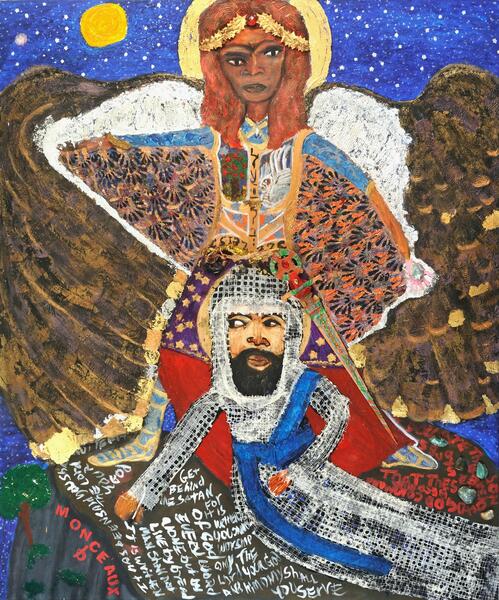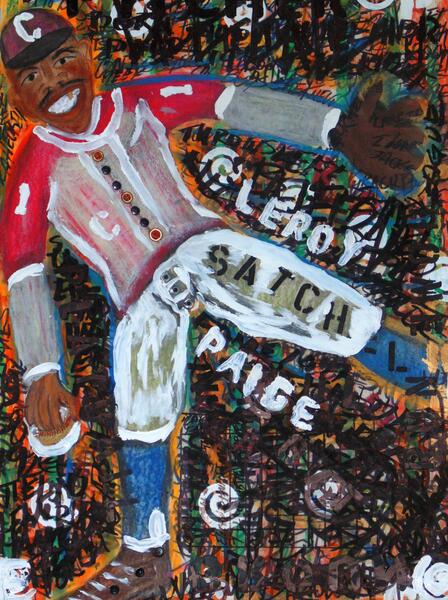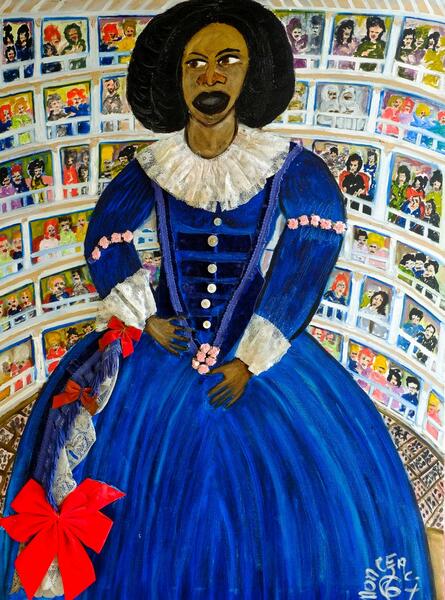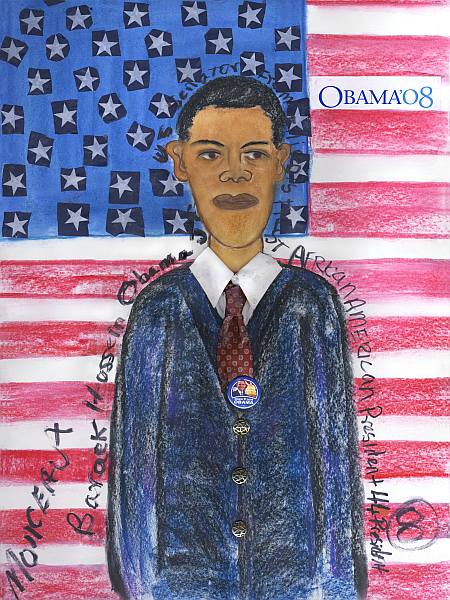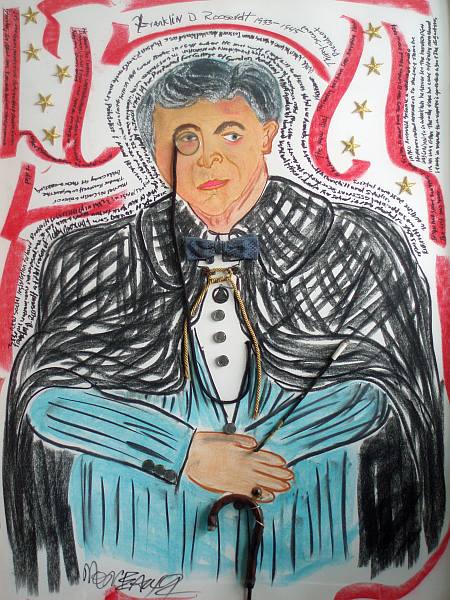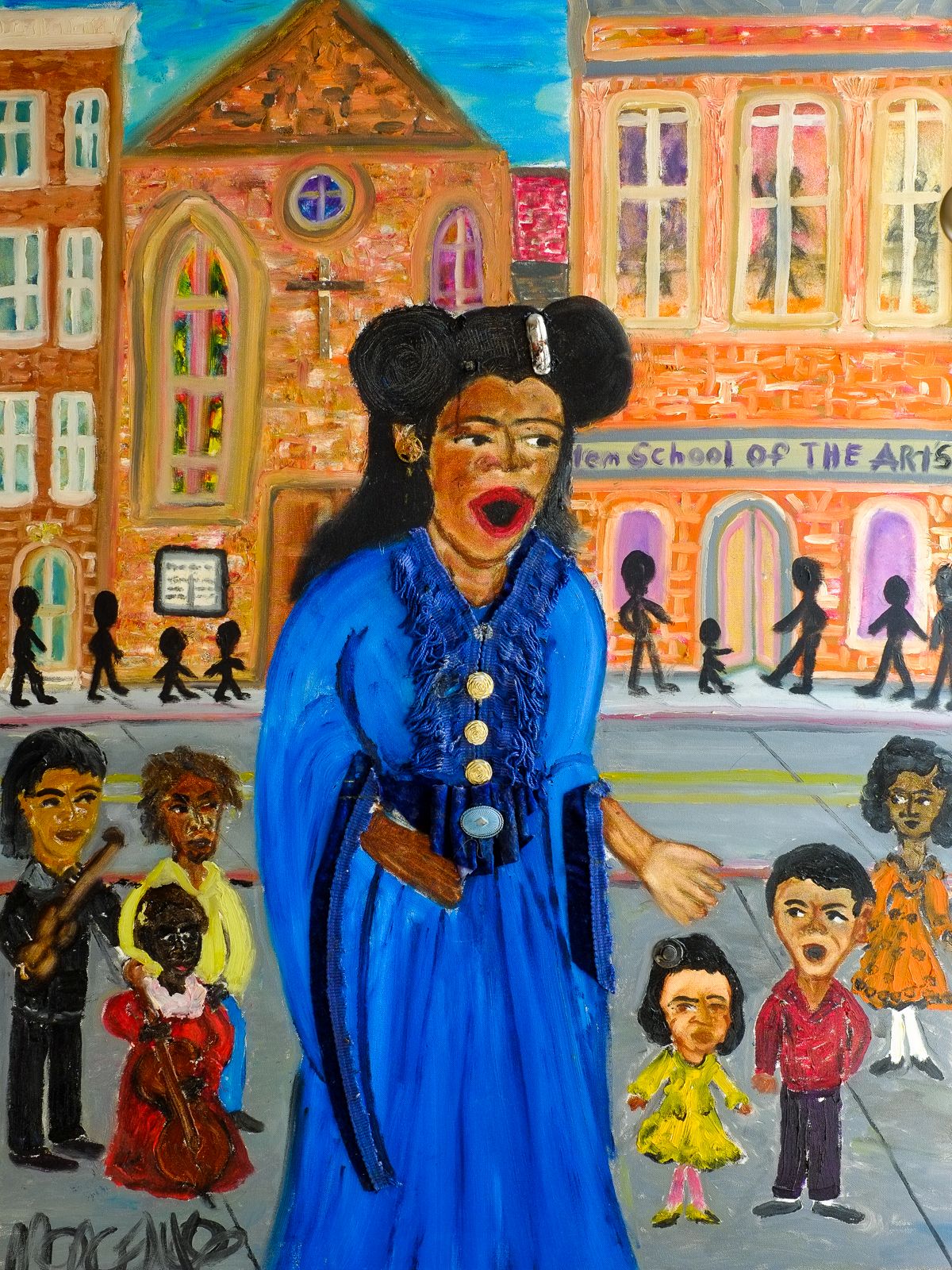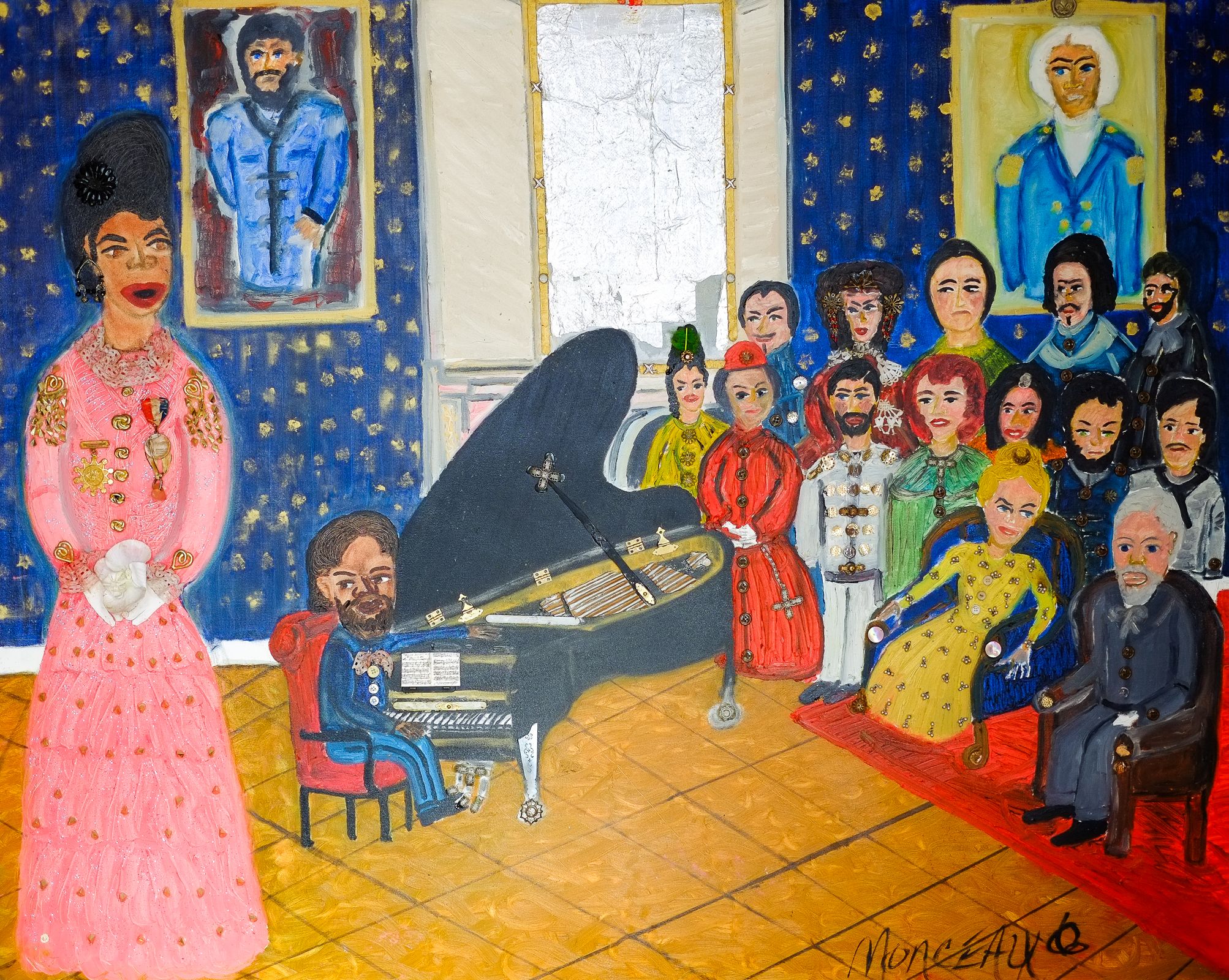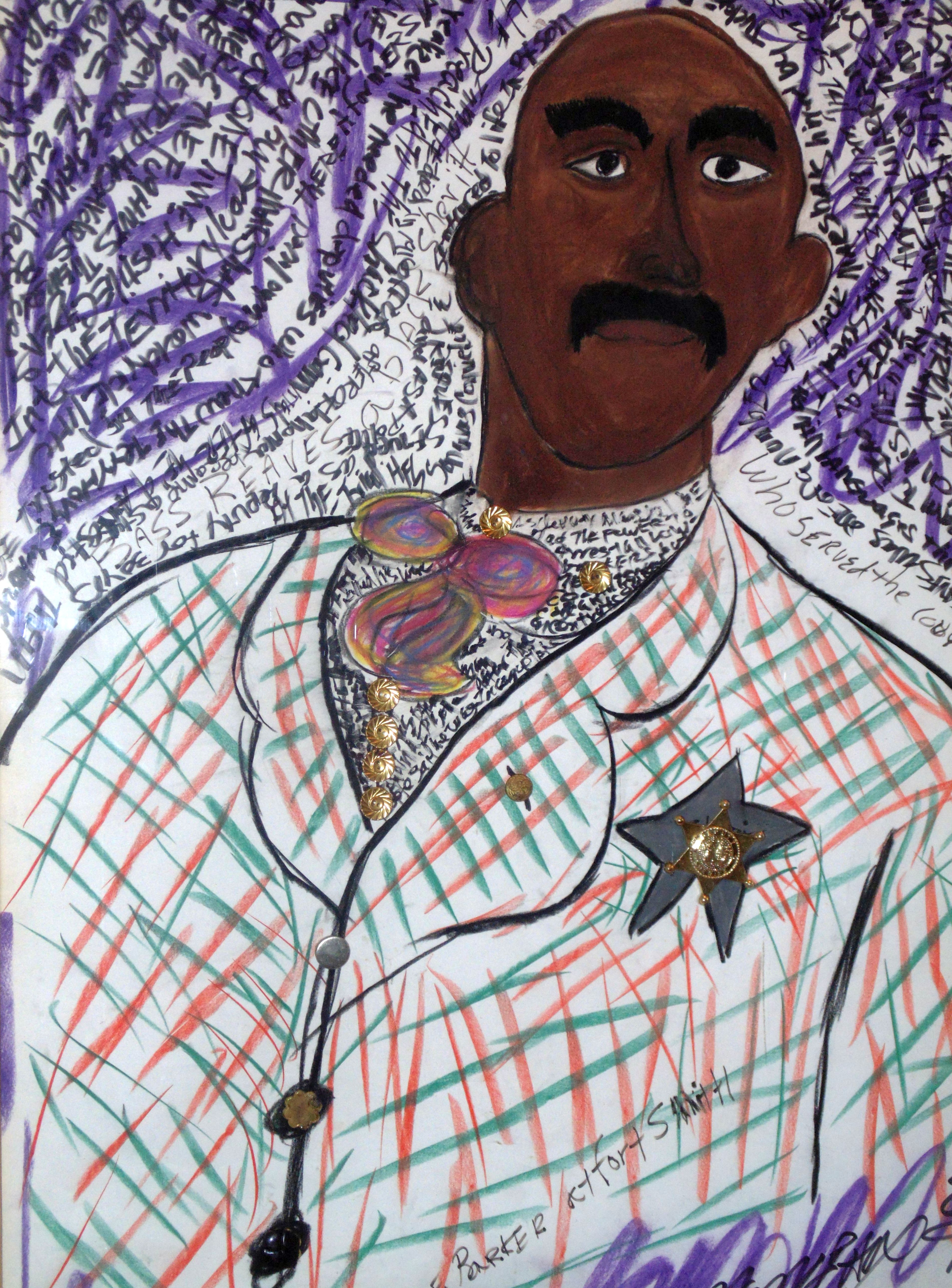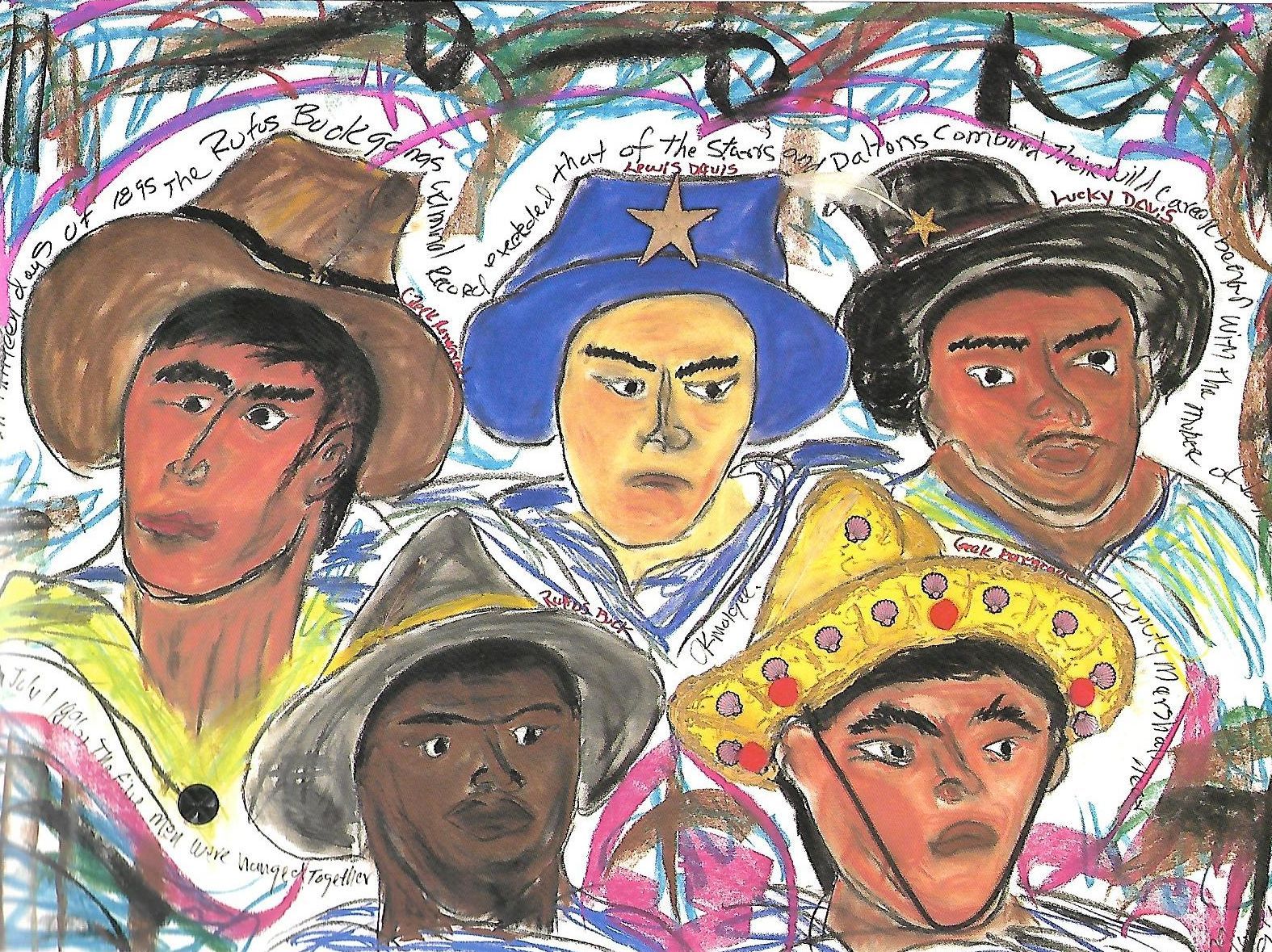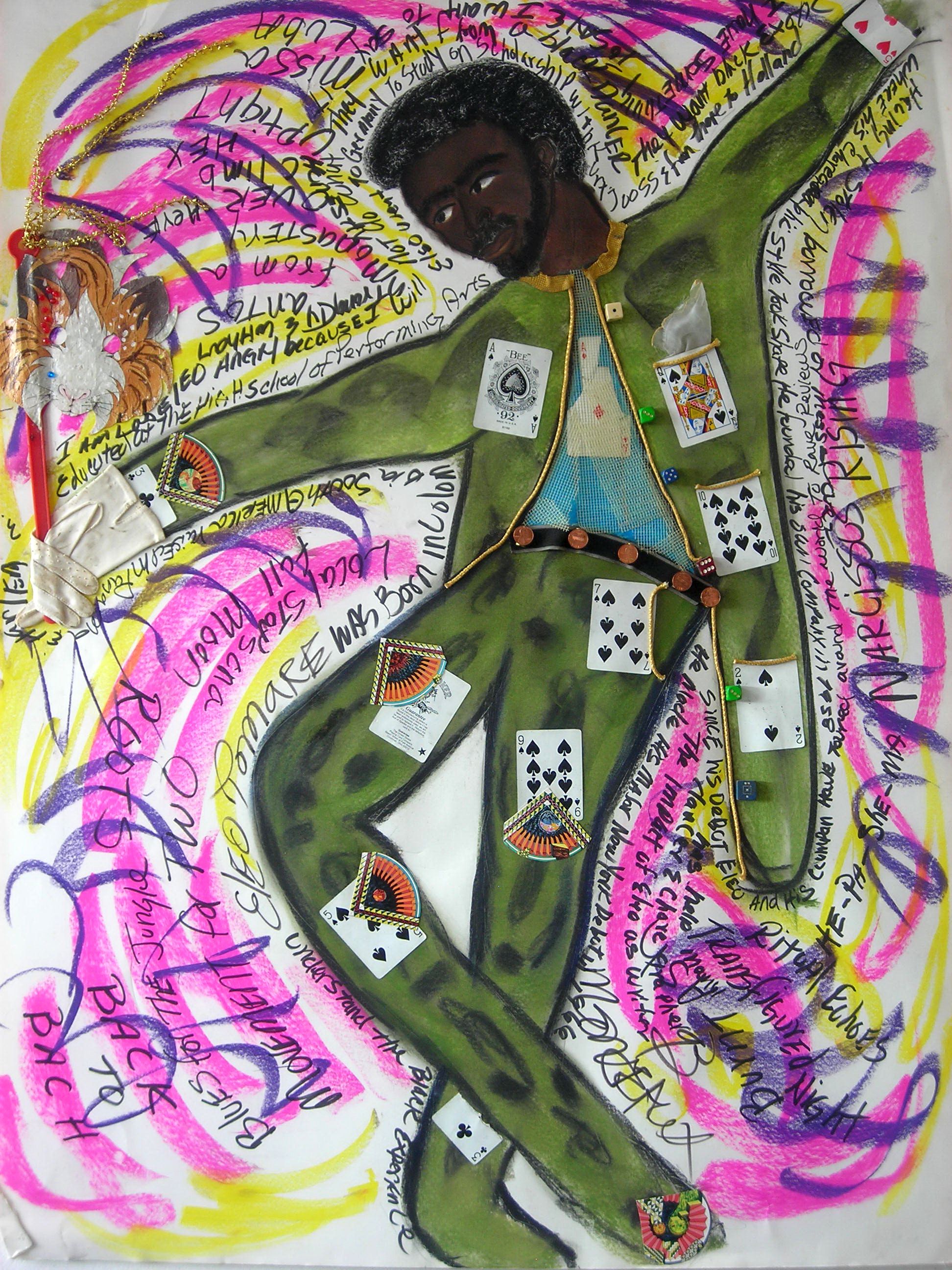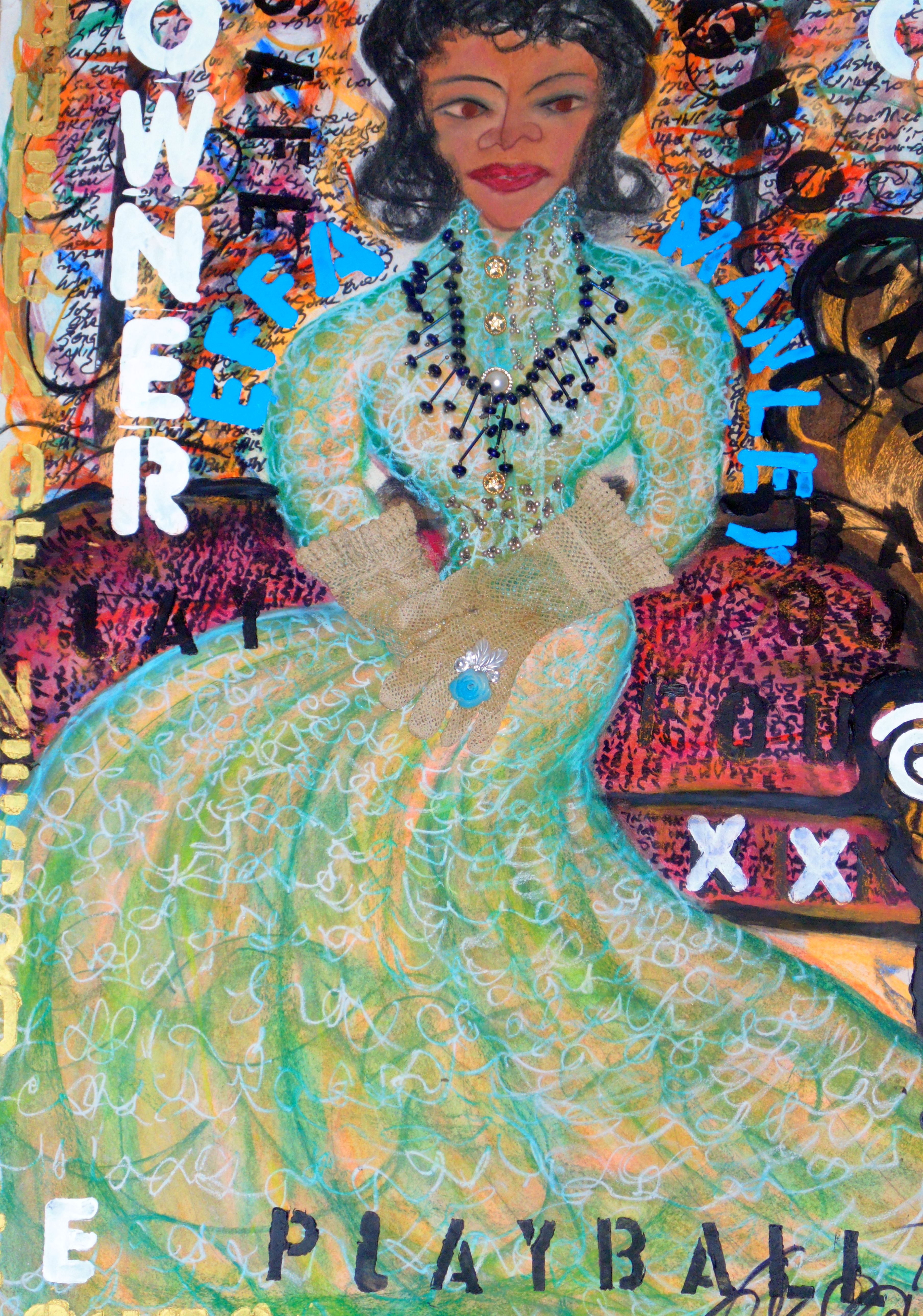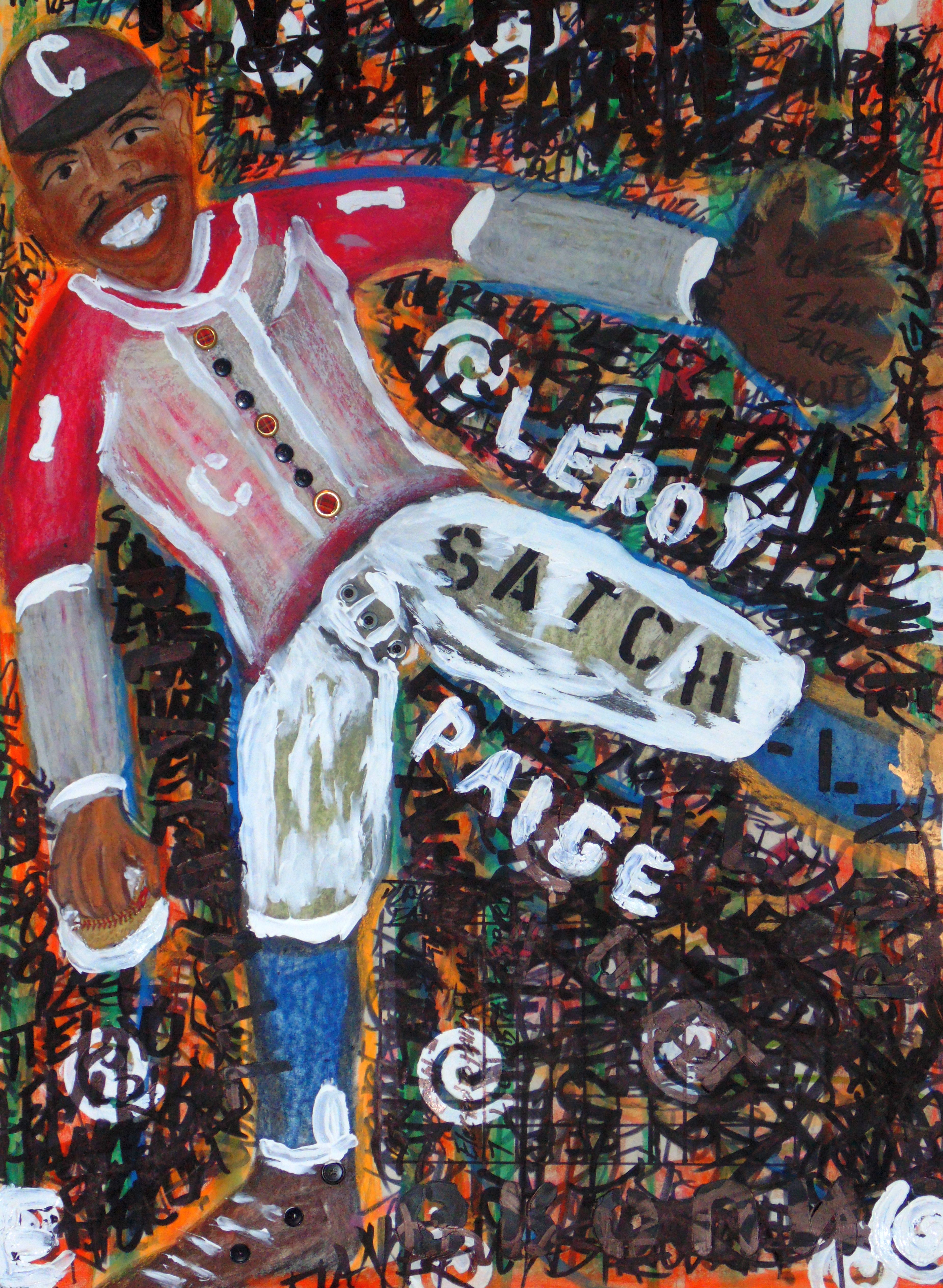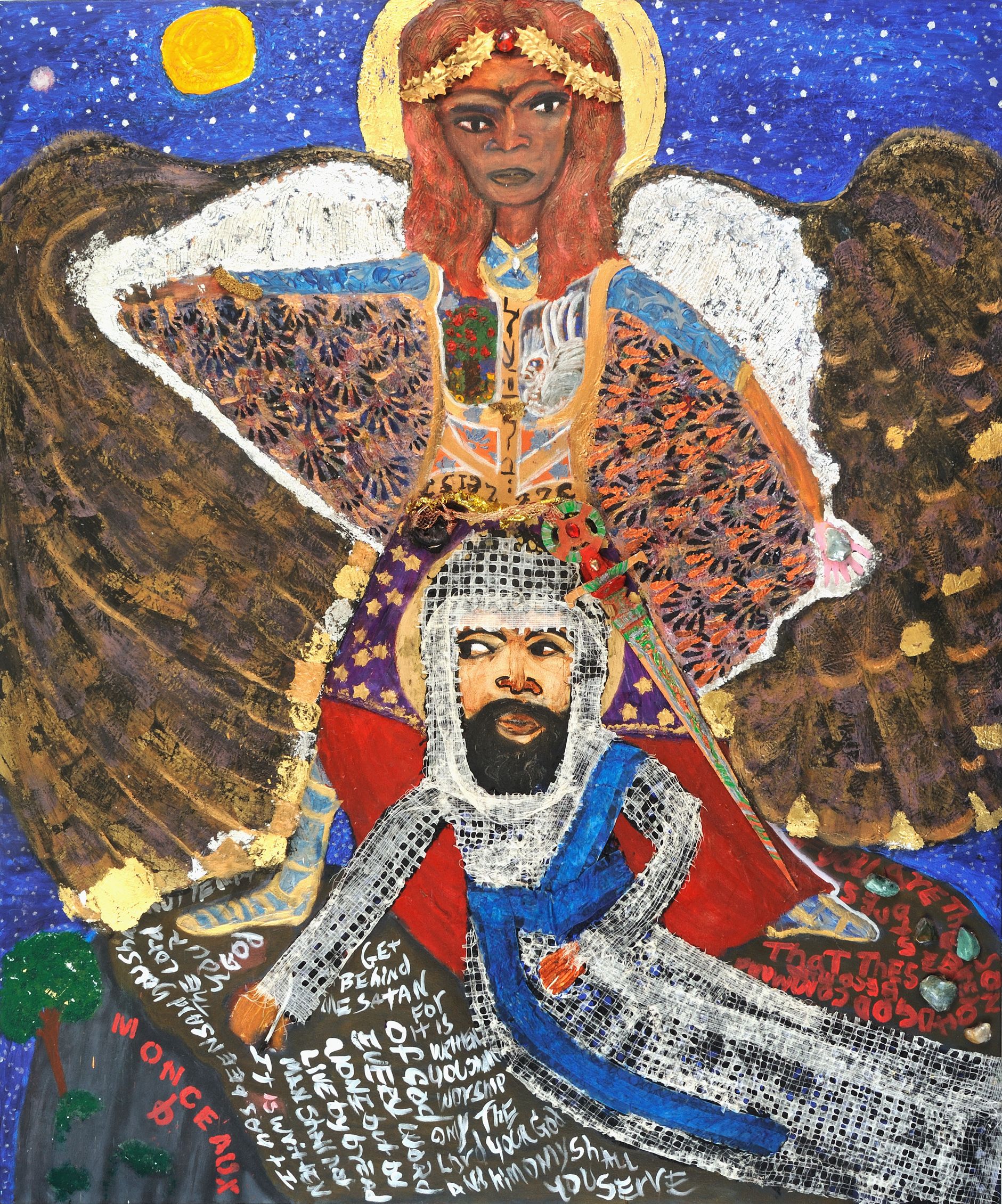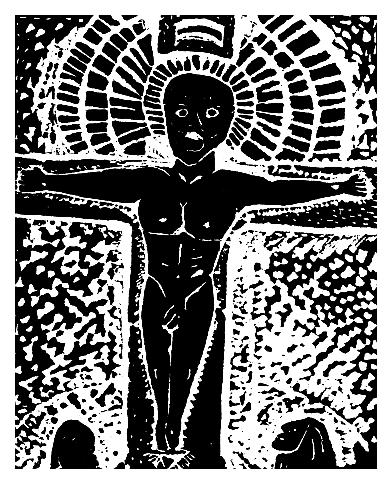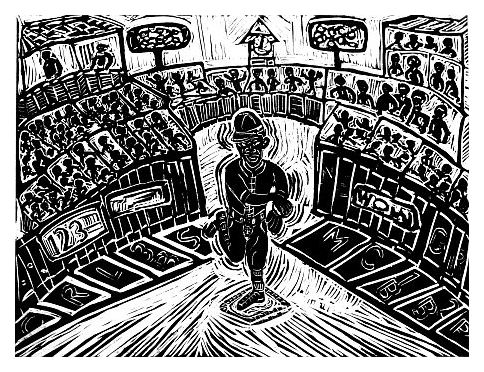Work samples
-
The Cost of Not Preventing Crack BabiesThis is an installation performance piece incorporating headless baby dolls and is based on the universal theme of human frailty, tragedy and suffering - art reflects life. You, the viewer, as participants, are challenged to respond, to be alive and the value humankind. My intention was to draw attention to the problem of crack addiction and to highlight where the responsibility lies.
About Morgan

Born to a wealthy, established Creole family in Louisiana in 1945, I grew up attending segregated schools and attended Bishop College in Dallas, Texas, for three years before doing two tours of duty with the Navy in Vietnam between 1964 and 1973. When I returned home from Navy duty, curiosity as to my standing as a black man and an American citizen drove me to see how the rest of America lived. So, for 17 years thereafter, I… more
Hail to The Chief
Incorporating historical research into my drawings, paintings, and collaged portraits, these works on paper are comprised of oil and acrylic paint, paste, magic marker, and recycled objects. Campaign buttons, ribbons, sequins, fabric and costume jewelry, fragments of plastic, wood, and leather were reclaimed from obsolescence and fashioned for artistic purposes.
I began this series intrigued with the idea that some of our presidents may have had African American/mixed ancestry. The series comes full circle with Barack Hussein Obama being the first black US president with a mixed racial heritage and, indeed, his wife Michelle being the first black First Lady.
The first six portraits in this project are presidents whose racial heritage has been questioned by scholars. Naturally, with DNA testing – if allowed – these questions could be answered. For the moment, the academic consensus does not support the claims made by so-called amateur historians. The other two are counted among those considered to be popular.
-
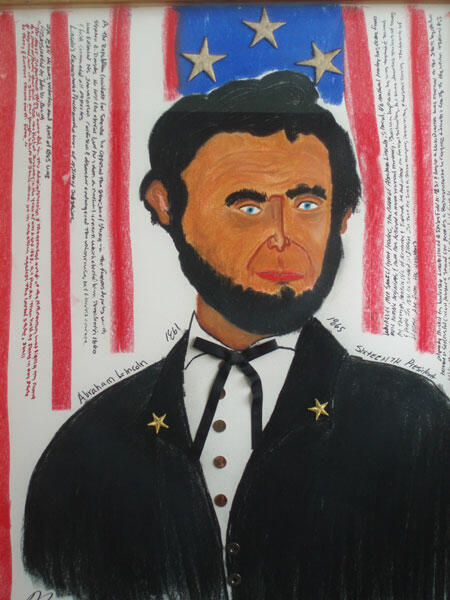 Abraham Lincoln40in x 30in. Mixed media on paper with found objects.
Abraham Lincoln40in x 30in. Mixed media on paper with found objects. -
 Thomas Jefferson40in x 30in. Mixed media on paper with found objects.
Thomas Jefferson40in x 30in. Mixed media on paper with found objects. -
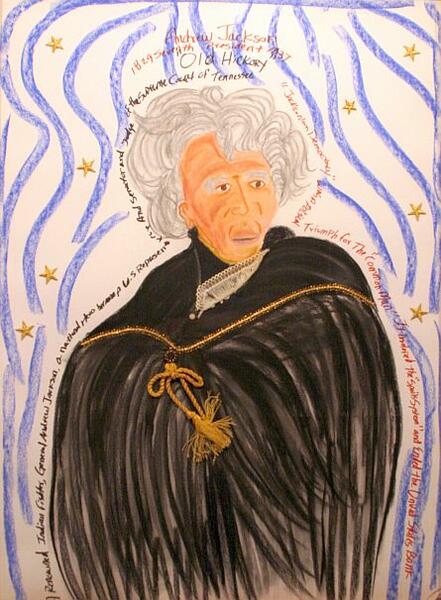 Andrew Jackson40in x 30in. Mixed media on paper with found objects.
Andrew Jackson40in x 30in. Mixed media on paper with found objects. -
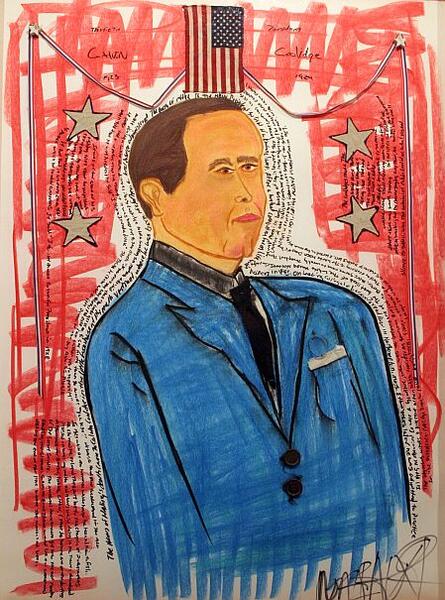 Calvin Coolidge40in x 30in. Mixed media on paper with found objects.
Calvin Coolidge40in x 30in. Mixed media on paper with found objects. -
 Dwight Eisenhower40in x 30in. Mixed media on paper with found objects.
Dwight Eisenhower40in x 30in. Mixed media on paper with found objects. -
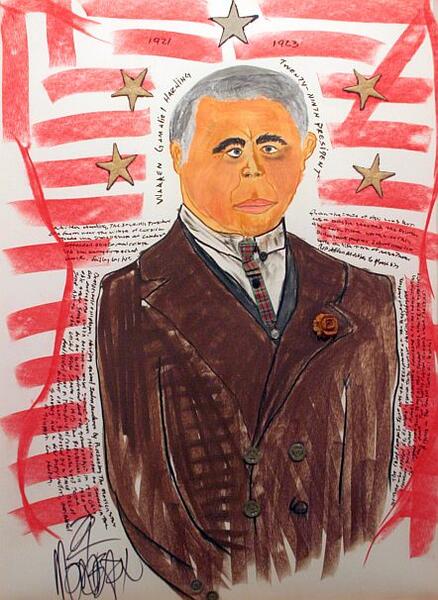 Warren Harding40in x 30in. Mixed media on paper with found objects.
Warren Harding40in x 30in. Mixed media on paper with found objects. -
 Barack Hussein Obama40in x 30in. Mixed media on paper with found objects.
Barack Hussein Obama40in x 30in. Mixed media on paper with found objects. -
 Franklin D Roosevelt40in x 30in. Mixed media on paper with found objects.
Franklin D Roosevelt40in x 30in. Mixed media on paper with found objects. -
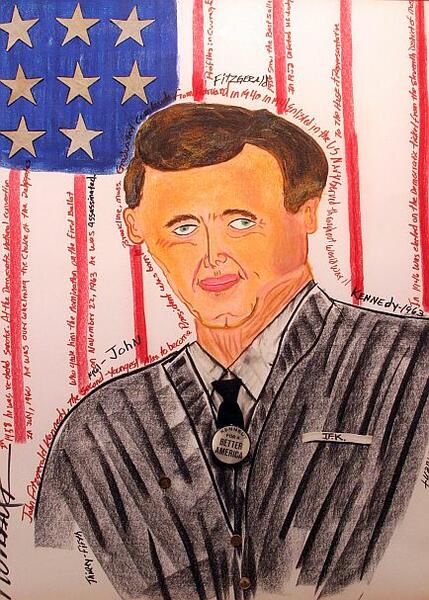 John F Kennedy40in x 30in. Mixed media on paper with found objects.
John F Kennedy40in x 30in. Mixed media on paper with found objects. -
Hail To The ChiefThis is the song I chose to accompany this series. It is available on Wikipedia.
Jazz: My Music, My People
This portfolio got its start in our living room during the 1950s as my sister and I listened to my mother, a blues singer, rehearse material for her club performances. When I was a child, I did not think of jazz as a separate body of music. It was just what we listened to every day growing up in Louisiana.
In my family, everyone sang. I didn't take singing lessons from a music teacher…I had my mother. Her grandfather was a minister, and we all sang for him in church: my mother, my grandmother, my great-grandmother, my sister, me. Whenever it was required, we sang for him.
We sang for ourselves, too, and played the piano. And that's how every musician I've included in this portfolio started out - singing or playing an instrument for themselves and for those around them. They were young, often still in their teens, when they started making a living as musicians. In the early years of jazz, they were almost never formally trained. They were professional musicians in the days when no African American, no matter how accomplished, could play in a symphony orchestra.
The musicians in this portfolio are the great rule-breakers of our time. Like all musicians, they listened to the music around them and learned to play what they heard. And then they created new sounds – a distinct American and African-American music that had never been heard before…it’s like storytelling. One person hears something and passes it on. Buddy Bolden influenced a new generation of New Orleans brassmen, including Louis Armstrong, who influenced Dizzy Gillespie, who influenced Miles Davis. Lester Young’s saxophone influenced Charlie Parker, who influenced John Coltrane, who continues to influence many others. As one performer listens to another, bringing personal experience to their improvised sounds, a music evolves. We can hear it in recordings that nearly, but not quite, span the lifetime of jazz. We can hear it in the songs of Bessie Smith and Billie Holiday and the singers who followed, as they learned to use their voices like a musical instrument. We can hear the instrumentalists emulating the singers in turn.
As we grew up, my sister and I were encouraged to make something of ourselves, to find role models who were black, people we could look up to and be proud of. Someone like Nat King Cole meant the world to my family, because he was the first African-American to have his own television show – the first. My grandparents wanted me to be able to say, “I have ability and talent, I have something to offer the world and I am good at what I do.”
Music has been a part of every day of my life, and during the hard times, it helped me hold my sanity. With this portfolio, I wanted to put my emotional response to music into paintings. And I wanted to tell the stories of the performers who brought their own experiences and emotions as Americans and African-Americans to their concerts and jam sessions and recordings. But if you have never listened to the music, my paintings can’t tell you everything. After you have looked at this portfolio…listen…to Leadbelly, Bessie Smith, Miles Davis, Louis Armstrong. They have their own stories to tell. You can hear it in the music.
-
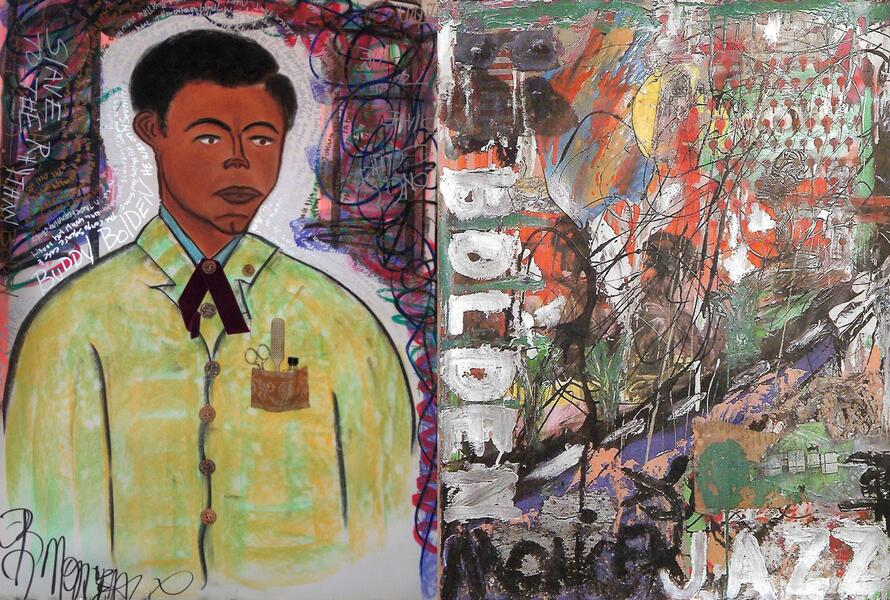 Buddy Bolden40in x 30in. Mixed media on paper with found objects. The image on the right is an abstract.
Buddy Bolden40in x 30in. Mixed media on paper with found objects. The image on the right is an abstract. -
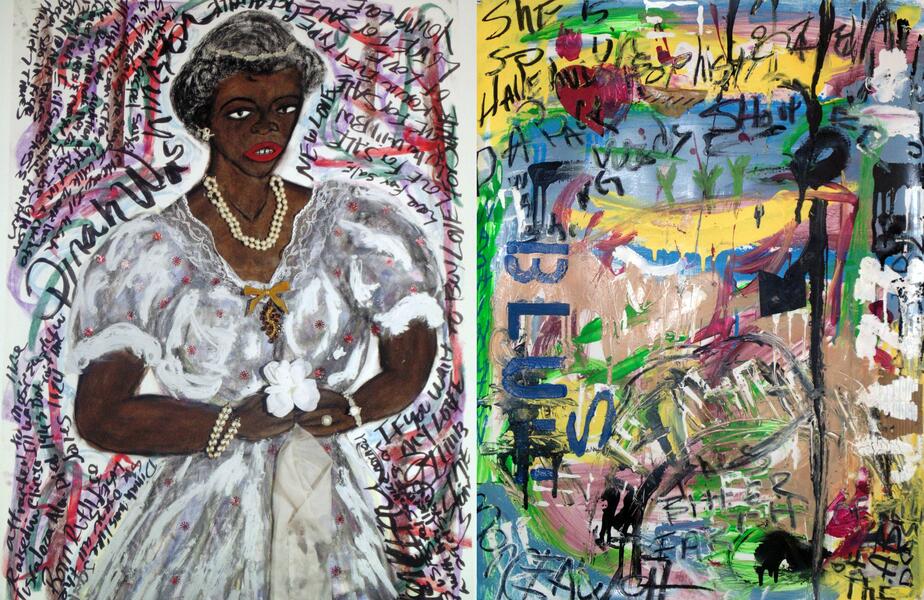 Dinah Washington40in x 30in. Mixed media on paper with found objects. The image on the right is an abstract. This image is one of three from the Jazz series that are in the permanent collection of the National Portrait Gallery Smithsonian Institution.
Dinah Washington40in x 30in. Mixed media on paper with found objects. The image on the right is an abstract. This image is one of three from the Jazz series that are in the permanent collection of the National Portrait Gallery Smithsonian Institution. -
Star EyesThis piece is by jazz pianist Marc Carey. Gifted to Morgan Monceaux for this project by Rose Weaver who holds the copyright.
-
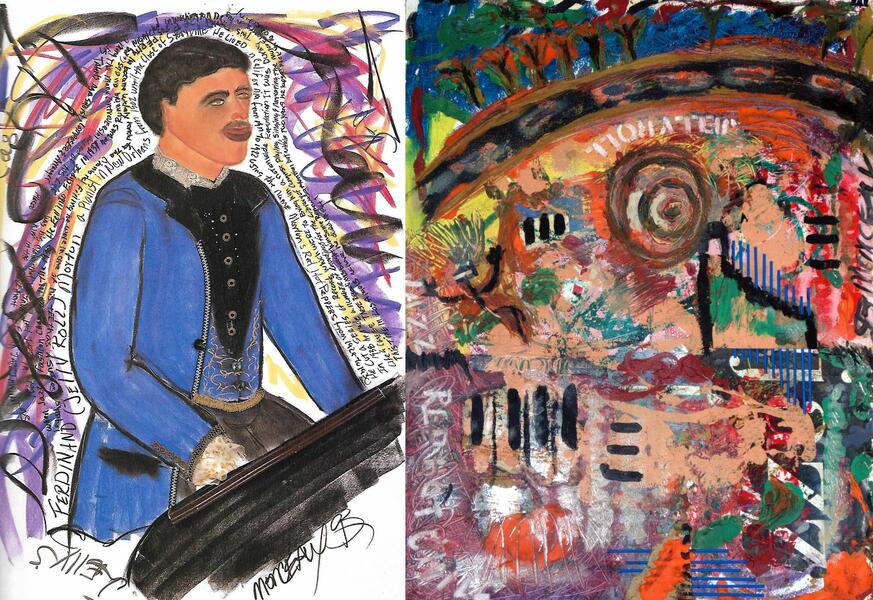 Ferdinand 'Jelly Roll' Morton40in x 30in. Mixed media on paper with found objects. The image on the right is an abstract.
Ferdinand 'Jelly Roll' Morton40in x 30in. Mixed media on paper with found objects. The image on the right is an abstract. -
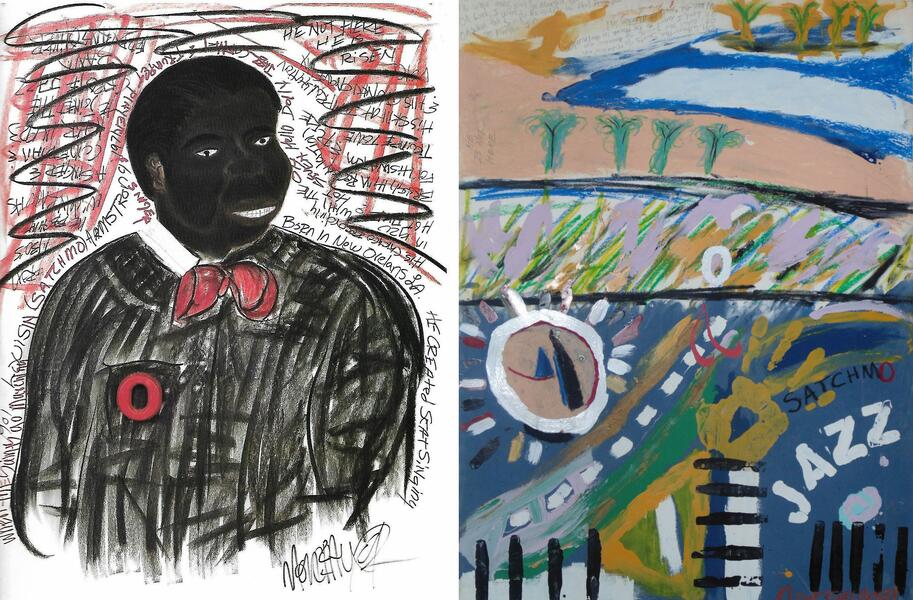 Louis Armstrong40in x 30in. Mixed media on paper with found objects. The image on the right is an abstract.
Louis Armstrong40in x 30in. Mixed media on paper with found objects. The image on the right is an abstract. -
Strange FruitThis piece is by Rose Weaver who holds the copyright. It was gifted to Morgan Monceaux specifically for this project.
-
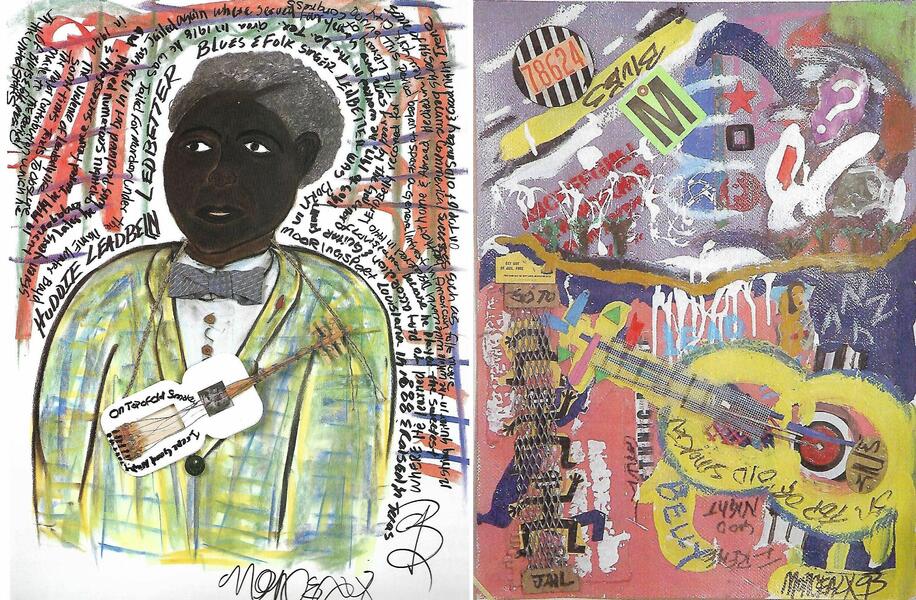 Huddie 'Leadbelly' Ledbetter40in x 30in. Mixed media on paper with found objects. The image on the right is an abstract.
Huddie 'Leadbelly' Ledbetter40in x 30in. Mixed media on paper with found objects. The image on the right is an abstract. -
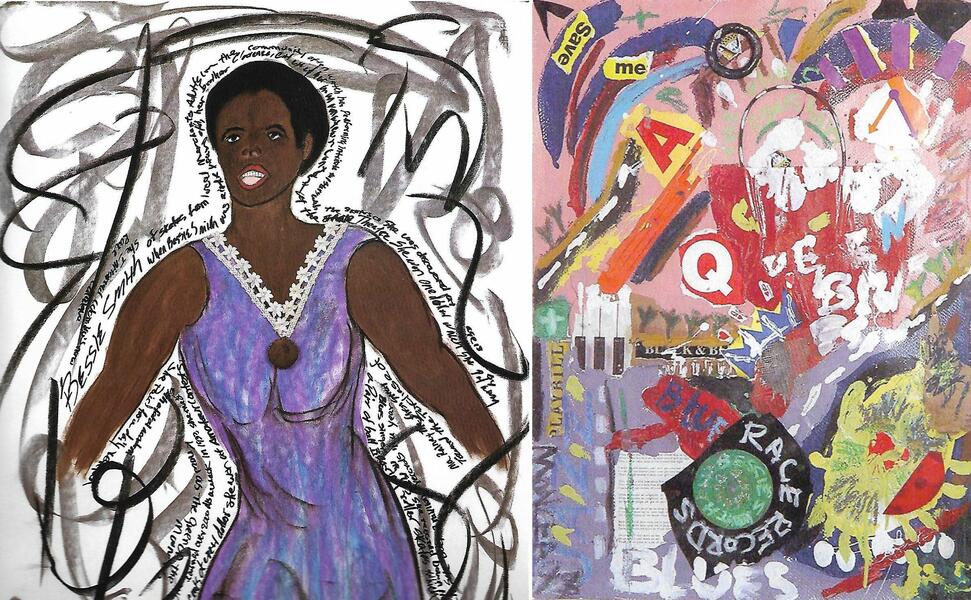 Bessie Smith40in x 30in. Mixed media on paper with found objects. The image on the right is an abstract.
Bessie Smith40in x 30in. Mixed media on paper with found objects. The image on the right is an abstract. -
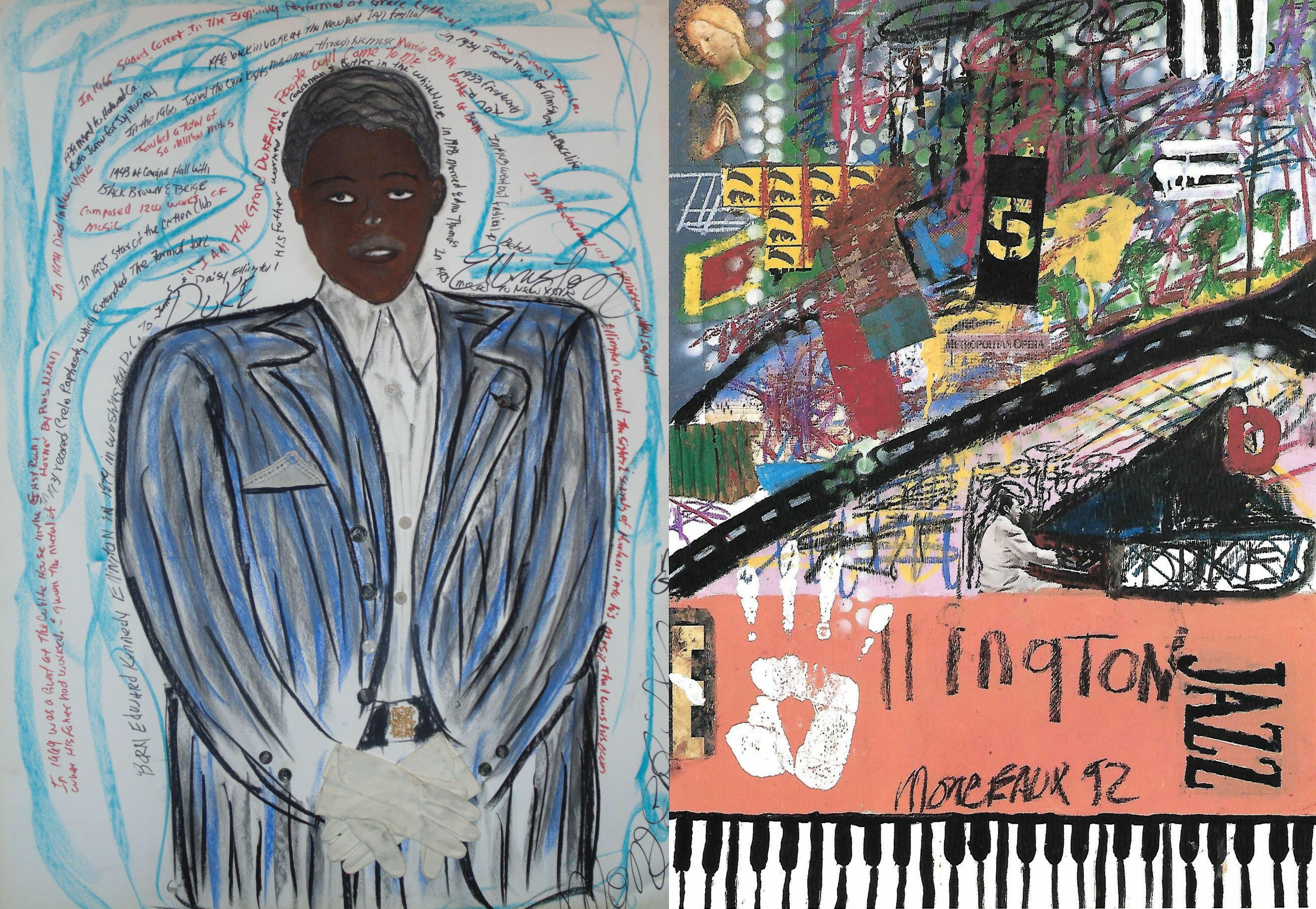 Duke Ellington40in x 30in. Mixed media on paper with found objects. The image on the right is an abstract. This portrait is one of three that are part of the permanent collection of the National Portrait Gallery Smithsonian Institution.
Duke Ellington40in x 30in. Mixed media on paper with found objects. The image on the right is an abstract. This portrait is one of three that are part of the permanent collection of the National Portrait Gallery Smithsonian Institution. -
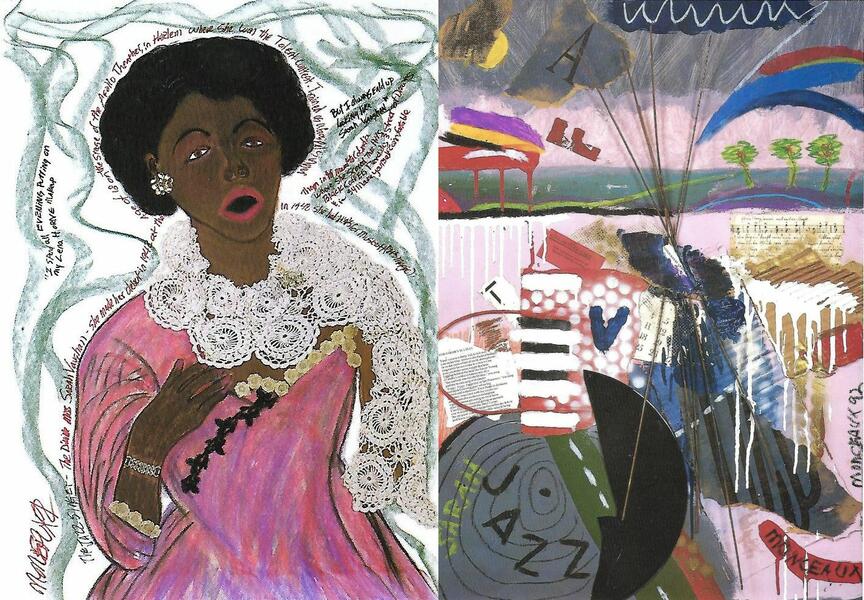 Sarah Vaughan40in x 30in. Mixed media on paper with found objects. The image on the right is an abstract.
Sarah Vaughan40in x 30in. Mixed media on paper with found objects. The image on the right is an abstract.
And So I Sing
The following piece was originally written by Robert Dilworth, Professor of Art at the University of Rhode Island in 1999. It has been adapted to reflect the work that is being shown in this portfolio.
We all know the music of black people. Music that comes from the deep bowels of the black soul. Music that began in a distant land, its syncopation and rhythm redefined in the fields of the southern delta in times almost forgotten. Music played in the juke joints and crowded shacks along narrow winding Mississippi roads. Music re-tempo-ed and re-issued to fill the dance halls and night clubs of northern cities. Music modified and echoed by almost every known popular musician. Some called it Boogie Woogie, some called it Bebop, some called it Jazz, some called it Blues, some call it Hip Hop and some call it House. It all comes from the same place. It all resonates with the same cultural and emotional urgency. The souls of black folk remain deeply embedded in this music. The soul of America is irrefutably shaped by it.
However, little is known about those black women in history who sang classical music. Those women who beat all odds to appear in recital halls and on operatic stages of the world. Who, through sheer talent and tenacity, out-maneuvered America's social and racial schizophrenia to be counted among the most gifted of classical singers. By all accounts they were exceptional. From Miriam Anderson, who was proclaimed by Toscanini as having a voice that is heard only once every hundred years, to Jessye Norman whose Olympian voice catapulted her to international fame in the early 80s. And there were others. In the nineteenth century – Sissieretta Jones, Elizabeth Taylor-Greenfield, Marie Selika, and the Hyers sisters, to those who came later such as Anne Brown, Camilla Williams, Dorothy Manor, Abbie Mitchell, Leontyne Price, Martina Arroyo, and Kathleen Battle, to name a few. Thus, the wave of black operatic and recital stars was relentless.
In Morgan Monceaux's collection of oils on canvas entitled “And So I Sing”, he pays homage to the women who were triumphant in this music. “Divas”, he calls them, and divas they are.
But what is a diva, a black diva in particular? What separates her from all other singers, many of whom sing the same songs but do not reach “diva” status? In other words, what are the primary ingredients in becoming and remaining a diva? The textbook definition is taken from the Latin word meaning “goddess, or divine one”. These questions led me to think of ten points that all the women above and many others share. To me, in every case they (1) made themselves from scratch, (2) in their own way formed and defined the black female stage presence, (3) sacrificed all for their music, (4) confessed to no crimes of the heart, (5) instilled remembrance, (6) had no fear, (7) committed to love, (8) were real, (9) undressed and then re-outfitted the soul, and (10) created a safe harbor in us all.
They each are not just a mere object de luxe, as many would have them, but a particular embodiment of black cultural heritage. In short, they are a necessary part of defining the black cultural whole.
Throughout twentieth-century America artists have turned to musical forms such as jazz, blues, and classical music to inspire specific artworks or to be the models from which a work is shaped. Monceaux often uses music to provide a ground for his paintings, drawings and prints. This group of oil paintings testifies to his (then) ever-expanding range of images based on the continuing theme of Black Music America. Like Romare Bearden, William H. Johnson, Archibald Motley, and a host of other black artists before him, Monceaux explores and reconstructs the psychological underpinnings that has given rise to black music and that makes it so enduring. Using the elements of visual design and printmaking, then following through different aspects of the entire series with pastels and oils, he sifts through the interior spaces of black musical culture to form the corpus of “Divas”. Collectively, they constitute a world within itself.
These scenic portraits, categorized as “Divas Three”, place the subject in full professional perspective. The drama of stance, stage and costume are meticulously structured in support of the moment– the diva emerging mid-note, opulent and composed.
Clearly, Monceaux has given us an alternate vision of the “Diva”. These are not just depictions of singers who made musical history but women whose lives confronted and exemplified the conflicts of a world constantly changing. Perhaps the diva can be best summed up in a poem by Langston Hughes. In Down and Out Hughes writes:
If you loves me
Help me when I'm down an' out
If you loves me
Help me when I'm down an' out.
Cause I'm a po' gal that
Nobody gives a damn about.
-
Divas VoiceoversThese voice-overs are taken from a 3-CD compilation of music that accompanied the original exhibition of the Divas series. The compilations feature women that I consider to be modern "divas", regardless of music genre.
-
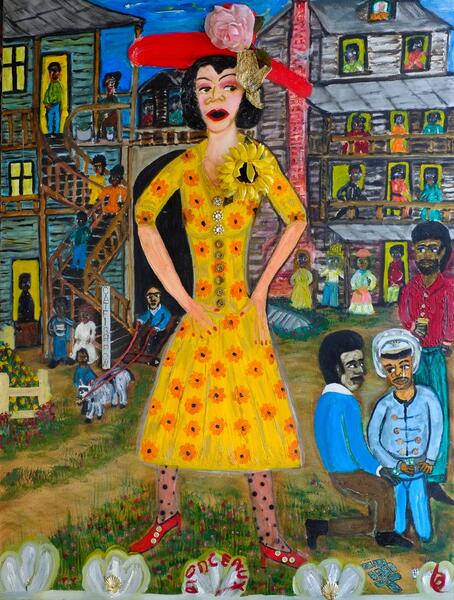 Anne Brown as BessAnne Brown, a native of Baltimore, was the first "Bess" from "Porgy and Bess" by Gershwin. 40in x 30in. Oils and mixed media with found objects on canvas.
Anne Brown as BessAnne Brown, a native of Baltimore, was the first "Bess" from "Porgy and Bess" by Gershwin. 40in x 30in. Oils and mixed media with found objects on canvas. -
 Dorothy Maynor40in x 30in. Oils and mixed media with found objects on canvas.
Dorothy Maynor40in x 30in. Oils and mixed media with found objects on canvas. -
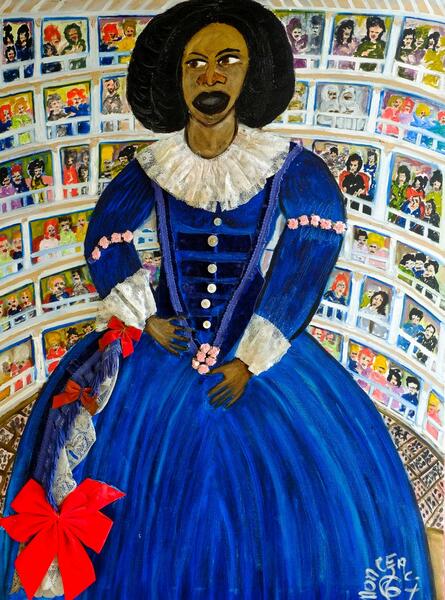 Elizabeth Taylor-Greenfield at Covent Garden Before Queen VictoriaThe first black person to perform before royalty. 40in x 30in. Oils and mixed media with found objects on canvas.
Elizabeth Taylor-Greenfield at Covent Garden Before Queen VictoriaThe first black person to perform before royalty. 40in x 30in. Oils and mixed media with found objects on canvas. -
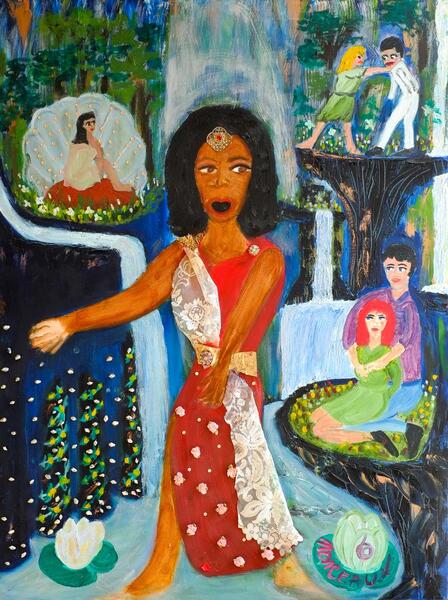 Grace Bumbry as The Black Swan in Wagner's Tannhauser40in x 30in. Oils and mixed media with found objects on canvas.
Grace Bumbry as The Black Swan in Wagner's Tannhauser40in x 30in. Oils and mixed media with found objects on canvas. -
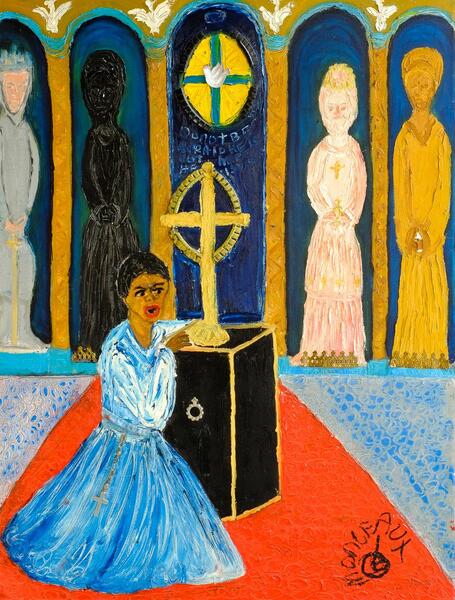 Hilda Harris in the Martyrdom of Saint Magnus40in x 30in. Oils and mixed media with found objects on canvas.
Hilda Harris in the Martyrdom of Saint Magnus40in x 30in. Oils and mixed media with found objects on canvas. -
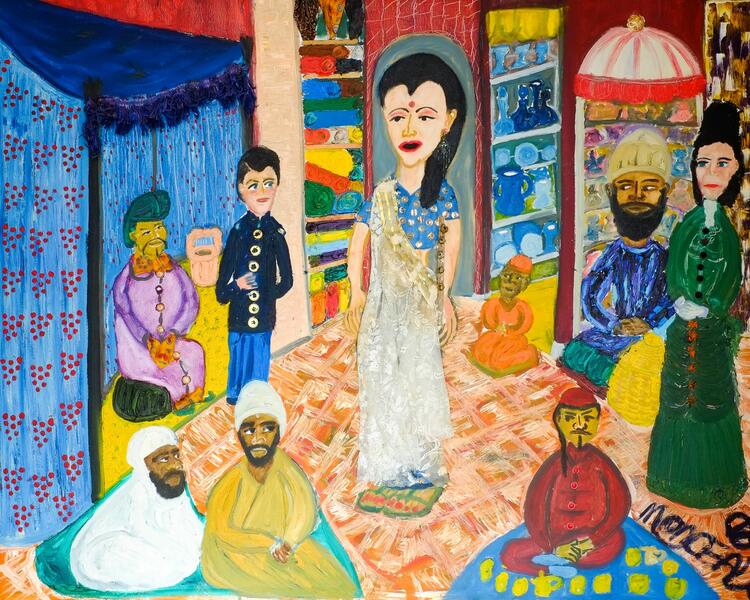 Lillian Evanti48in x 60in. Oils and mixed media with found objects on canvas.
Lillian Evanti48in x 60in. Oils and mixed media with found objects on canvas. -
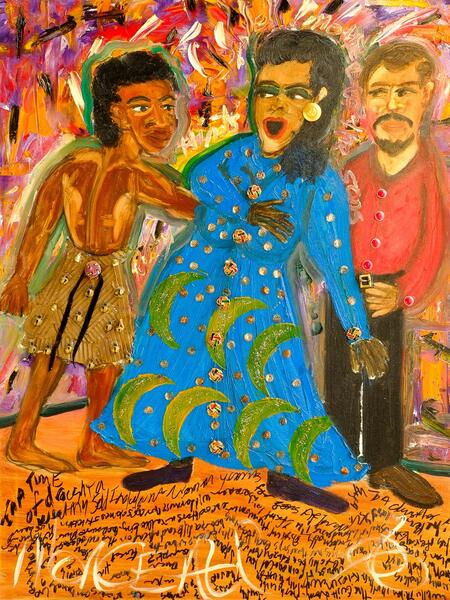 Ruby Hinds in A Mother And Her Three Sons by Bill T JonesThis dance/opera was inspired by folktales from sub-Saharan Africa. 40in x 30in. Oils and mixed media with found objects on canvas.
Ruby Hinds in A Mother And Her Three Sons by Bill T JonesThis dance/opera was inspired by folktales from sub-Saharan Africa. 40in x 30in. Oils and mixed media with found objects on canvas. -
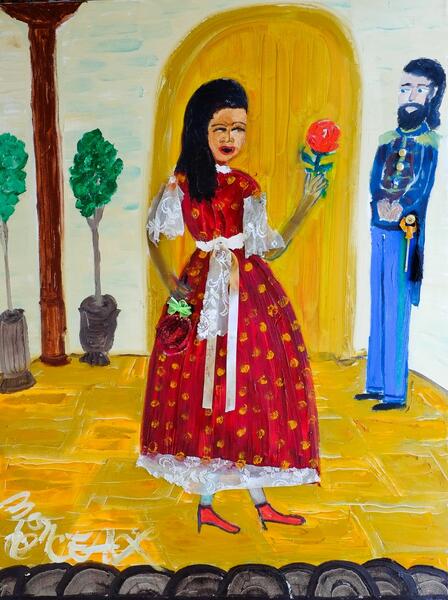 Shirley Verrett as Carmen40in x 30in. Oils and mixed media with found objects on canvas.
Shirley Verrett as Carmen40in x 30in. Oils and mixed media with found objects on canvas. -
 Sissieretta Jones Sings Home Sweet Home In The Blue Room48in x 60in. Oils and mixed media with found objects on canvas.
Sissieretta Jones Sings Home Sweet Home In The Blue Room48in x 60in. Oils and mixed media with found objects on canvas.
Black and Red: African Americans and Native Americans in the West
I grew up in Louisiana in a time when it was said that if you had just a drop of Negro blood you were black. I was eight years the summer I learned that I was also part Indian.
All that summer, our relatives kept arriving. I think my great-grandmother Nana knew she was dying, and she called her children and their families to pass along her blessing to them. They came from all over: Shreveport, Louisiana; Michigan; and Oregon. The cousins fit right in with the neighborhood kids, and every night after dinner we’d play cowboys and Indians. My friend Larry insisted on being the sheriff, because he had a badge. “There must be law and order in this black town,” he’d say.
It was my Uncle George who got us thinking about things. The first time I saw him, he was getting off the train in his cowboy boots and a big Mexican hat. He wore a gun belt but no guns. He was very tall and dark, with a big thick mustache, and when he walked he jangled. He smelled of cigars and rose water and sweat. I learned that night that he was Mama’s younger brother. He’d left home when he was thirteen, and had lived in Texas, California, and Mexico, where he owned a ranch.
Uncle George became a hero to us kids that summer. Every night he’d bring out a watermelon and talk to us about Mexico and its people, and about the West. He held us spellbound with his stories about cowboys and Indians, and our games took on a new life.
He started the other grownups talking, too. Mama told us about the Maroon people – fugitive slaves from the West Indies – in Florida. Our great-grandmother told us her mother was from the great Seminole nation that once ruled Florida, and she herself was the daughter of a Creek chief. My cousins and I realized that we had Indian blood in us, too.
One day Papa, my great-grandfather, came out of his workshop to stop a fight between a kid named Renard and my sister Elaine. Renard said there was no such thing as black soldiers in the West. We already knew better, but that day Papa told us about how the buffalo soldiers were called buffalo soldiers because people thought their hair looked like a buffalo’s mane.
Later that summer, Uncle Joe and Uncle George took us kids to Texas to see our first black rodeo. We knew about rodeos, but we had never heard of one where all the cowboys were black. I saw bulldogging for the first time. When we got home, I tried it on my dog Jeff, and he bit me.
That summer helped me see the connection between our games of cowboys and Indians – and the Wild West of the movies – and a history in which my family had a place. It showed me that our heritage included Native Americans, too, and it sparked my lifelong fascination with the West, which I’ve tried to capture in these portraits.
Taken from the book My Heroes, My People by Morgan Monceaux and Ruth Katcher, published by Frances Foster Books in 1999.
-
 Bass ReevesA black marshall of whom it was said that he preached to shackled criminals after he arrested them. 40in x 30in. Mixed media on paper with found objects.
Bass ReevesA black marshall of whom it was said that he preached to shackled criminals after he arrested them. 40in x 30in. Mixed media on paper with found objects. -
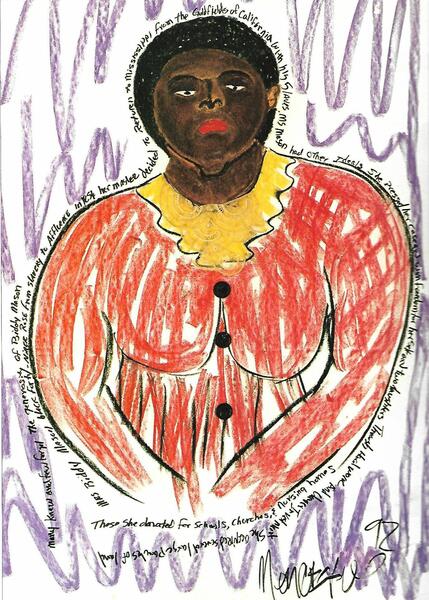 Biddy MasonA slave who became a woman of property. 40in x 30in. Mixed media on paper with found objects.
Biddy MasonA slave who became a woman of property. 40in x 30in. Mixed media on paper with found objects. -
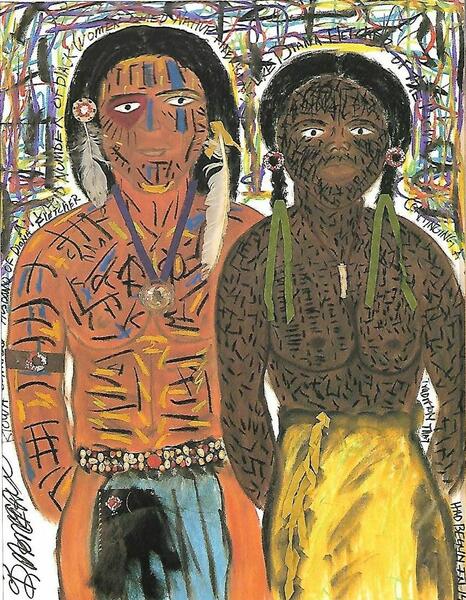 Diana FletcherA black woman who married a Kiowa Indian and lived with the Kiowa. 40in x 30in. Mixed media on paper with found objects.
Diana FletcherA black woman who married a Kiowa Indian and lived with the Kiowa. 40in x 30in. Mixed media on paper with found objects. -
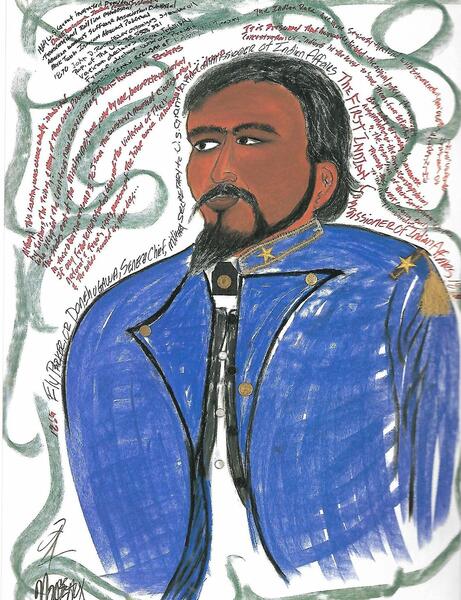 Ely ParkerA lawyer who couldn't argue a case in court because he was an Indian. 40in x 30in. Mixed media on paper with found objects.
Ely ParkerA lawyer who couldn't argue a case in court because he was an Indian. 40in x 30in. Mixed media on paper with found objects. -
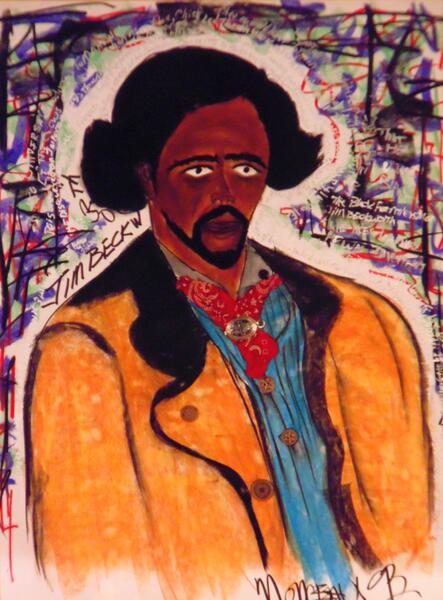 Jim BeckwourthThe slave who became a Crow chief and discovered a passage to the Far West. 40in x 30in. Mixed media on paper with found objects.
Jim BeckwourthThe slave who became a Crow chief and discovered a passage to the Far West. 40in x 30in. Mixed media on paper with found objects. -
 Mary FieldsAlso known as "Stagecoach Mary", she was a mail carrier who also ran a restaurant. 40in x 30in. Mixed media on paper with found objects.
Mary FieldsAlso known as "Stagecoach Mary", she was a mail carrier who also ran a restaurant. 40in x 30in. Mixed media on paper with found objects. -
 Nat Love"I was wild, reckless, and free, and afraid of nothing" 40in x 30in. Mixed media on paper with found objects
Nat Love"I was wild, reckless, and free, and afraid of nothing" 40in x 30in. Mixed media on paper with found objects -
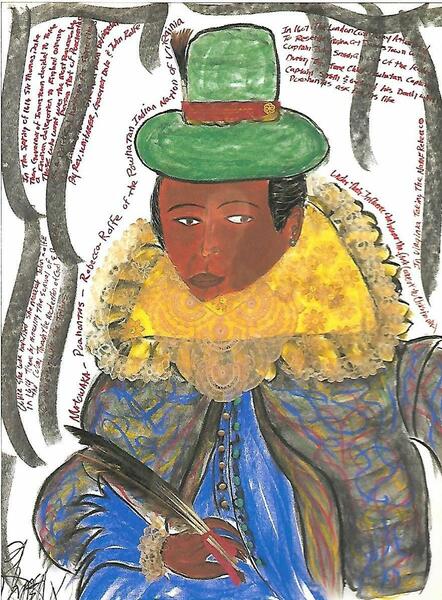 PocahontasThe Indian princess who became an English lady. This particular work was cited in Heike Paul's "The Myths That Made America" (published by [transcript], Germany, in 2014). 40in x 30in. Mixed media on paper with found objects.
PocahontasThe Indian princess who became an English lady. This particular work was cited in Heike Paul's "The Myths That Made America" (published by [transcript], Germany, in 2014). 40in x 30in. Mixed media on paper with found objects. -
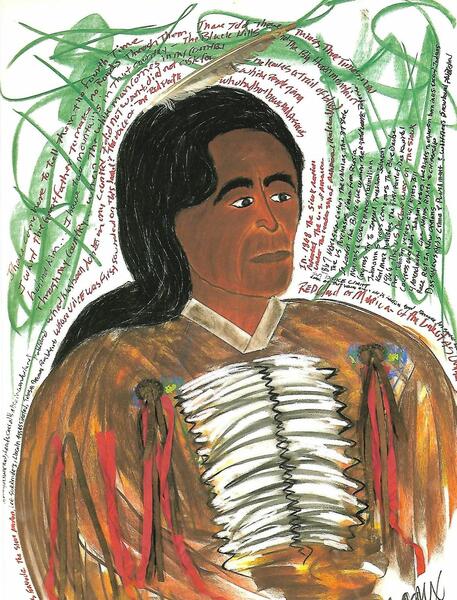 Red Cloud"The white children have surrounded me and left me nothing but an island" 40in x 30in. Mixed media on paper with found objects.
Red Cloud"The white children have surrounded me and left me nothing but an island" 40in x 30in. Mixed media on paper with found objects. -
 The Rufus Buck GangTrue outlaws. 30in x 40in. Mixed media on paper with found objects.
The Rufus Buck GangTrue outlaws. 30in x 40in. Mixed media on paper with found objects.
The Cost of Not Preventing Crack Babies
This exhibition and performance is based on the universal theme of human frailty, tragedy and suffering - art reflects life. You, the viewer, as participants, are challenged to respond, to be alive and to value humankind.
My intention was to draw attention to the problem of crack addiction and to highlight where the responsibility lies.
This piece was first performed at Artscape 2003 in Baltimore. The format was that of a funeral, complete with readings, personal testimonials and a final procession. Included within the space were headless baby dolls, drug paraphernalia and a coffin.
Originally recorded on VHS.
-
Crack BabiesThis is an installation performance piece incorporating headless baby dolls, entitled "The Cost of Not Preventing Crack Babies".
-
 Baby's Feeding BottleBaby's feeding bottle containing found objects
Baby's Feeding BottleBaby's feeding bottle containing found objects -
 Dark Headless DollHeadless doll
Dark Headless DollHeadless doll -
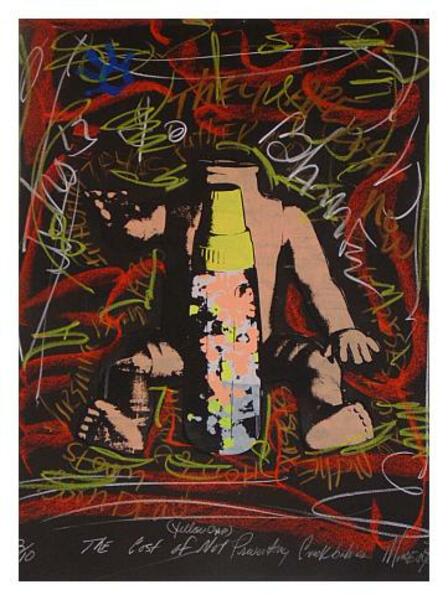 Crack Babies Silkscreen Print40in x 30in. Silkscreen print.
Crack Babies Silkscreen Print40in x 30in. Silkscreen print. -
crack_babies1.mp3This is an excerpt from an hour-long CD that accompanies the Crack Babies installation performance piece. The title is "Crack Attack" by Grace Jones which comes from the 1989 album "Bulletproof Heart" on the Capitol label.
The Royals
This series, begun in 1993/4, was exhibited at the American Visionary Art Museum for the first time in 2005 as part of a group show entitled “Race, Class, Gender (Is Not Equal To) Character”. What follows is an extract from the monograph prepared for the series by Claude Elliott, Independent Curator.
These works on paper are comprised of oil and acrylic paint, pastel, magic marker, and recycled objects. Buttons, string, sequins, fabric, costume jewelry, also fragments of plastic, wood, and leather are reclaimed from obsolescence and fashioned for artistic purposes.
The creative process begins with a pencil sketch outline, followed by details of the figure developed with oil and sometimes acrylic paint, dependent on the colors required and which materials are accessible. The goal is to quickly capture the essence of the personality, then design a visually compelling background, and lastly the placement of the text. Text written diagonally, upside down, right to left, left to right activates each portrait. The viewer is challenged to follow the text as it evolves around the figure of the subject outlining historical facts. The combination of text and painting are reminiscent of early illuminated manuscripts. They also resemble the engraved text and illustrations of the 19th century poet-painter William Blake.
The artist questions the fascination of Americans with European nobility. Children are taught about ideal beauty, class differences, and gender roles through fairy tales about Prince Charming, Snow White, and Sleeping Beauty. The 20th century weddings of the Norwegian Prince Harald V and Sonja Haraldsen in 1968 and the British Prince Charles and Diana Spencer in 1981 are clear examples of this fascination about race, class, wealth, and power. The idea that a ruler is chosen by divine providence and imbued with the divine right to sit on the throne is the focus of these paintings. While Americans turn towards Europe for the majestic, pageantry, and pomp and circumstance, Monceaux looks beyond the West and includes the continents of South America, Asia and Africa with its powerful dynasties dating back to 1375 B.C.
-
 His Holiness The Fourteenth Dalai Lama48in x 36in. Mixed media on paper with found objects.
His Holiness The Fourteenth Dalai Lama48in x 36in. Mixed media on paper with found objects. -
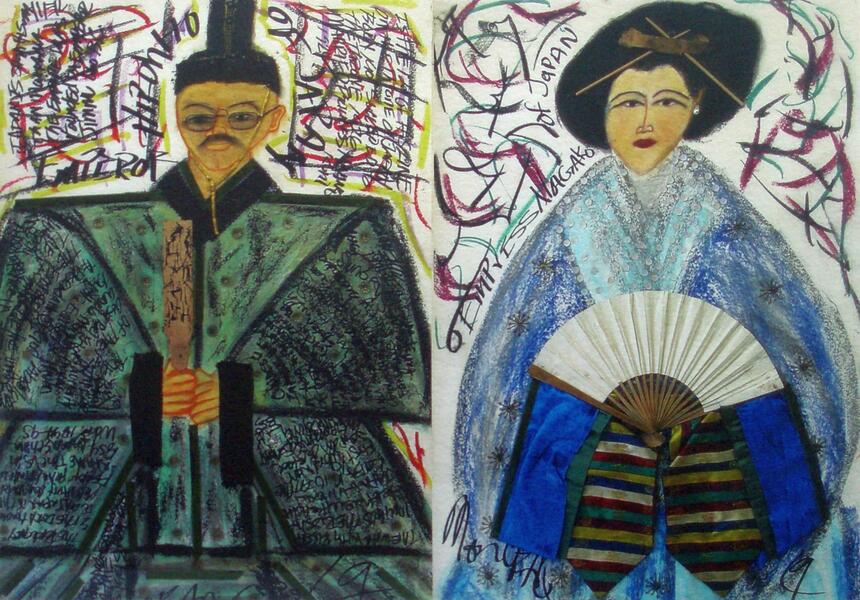 Emperor Hirohito and Empress NagakoEmperor Hirohito and Empress Nagako of The Last Kingdom of The Rising Sun. 48in x 36in. Mixed media on paper with found objects.
Emperor Hirohito and Empress NagakoEmperor Hirohito and Empress Nagako of The Last Kingdom of The Rising Sun. 48in x 36in. Mixed media on paper with found objects. -
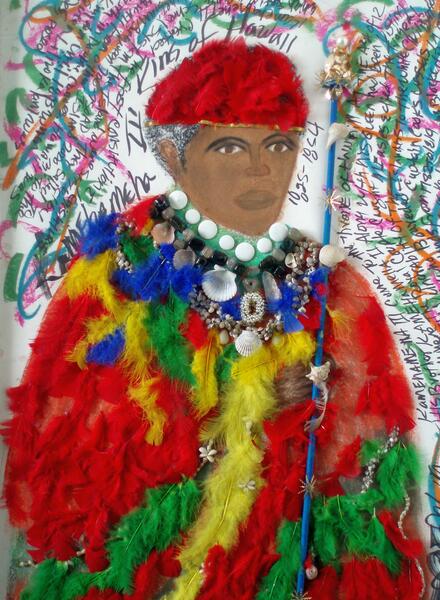 Kamahameha III King of Hawaii48in x 36in. Mixed media on paper with found objects.
Kamahameha III King of Hawaii48in x 36in. Mixed media on paper with found objects. -
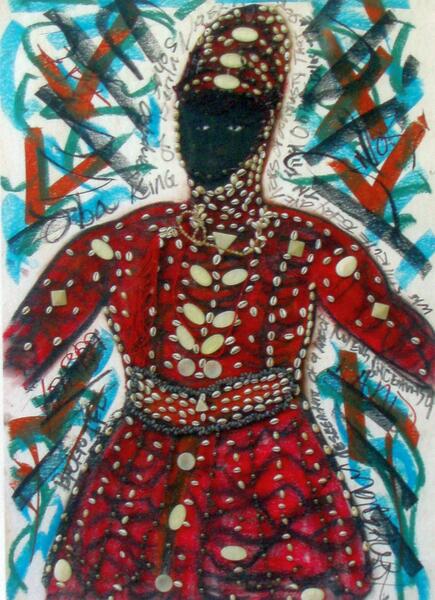 Oba King of Beninnkok and Ife48in x 36in. Mixed media with found objects.
Oba King of Beninnkok and Ife48in x 36in. Mixed media with found objects. -
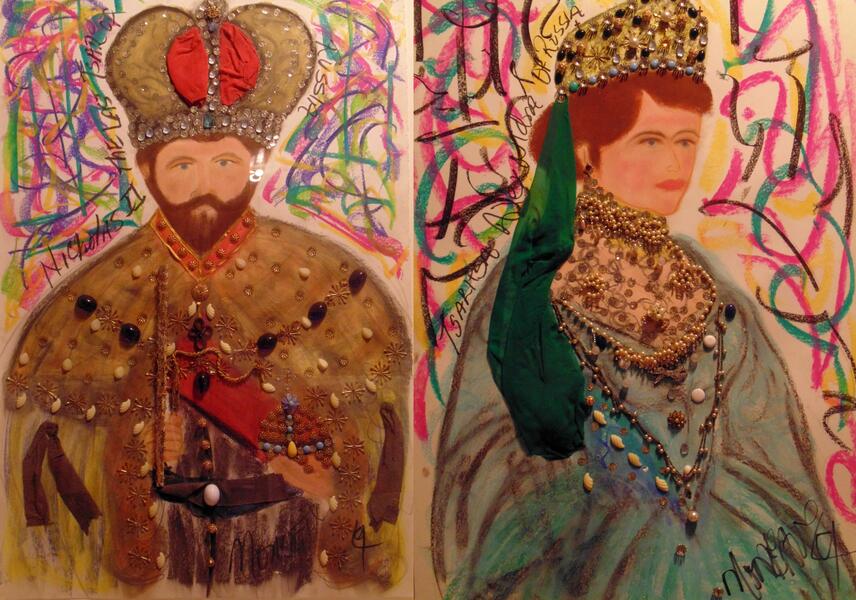 Nicholas II and Tsarita Alexandria of RussiaNicholas II The Last Csar of Russia and Tsarita Alexandria of Russia. 48in x 36in. Mixed media on paper with found objects.
Nicholas II and Tsarita Alexandria of RussiaNicholas II The Last Csar of Russia and Tsarita Alexandria of Russia. 48in x 36in. Mixed media on paper with found objects. -
 Queen of Tonga48in x 36in. Mixed media on paper with found objects.
Queen of Tonga48in x 36in. Mixed media on paper with found objects. -
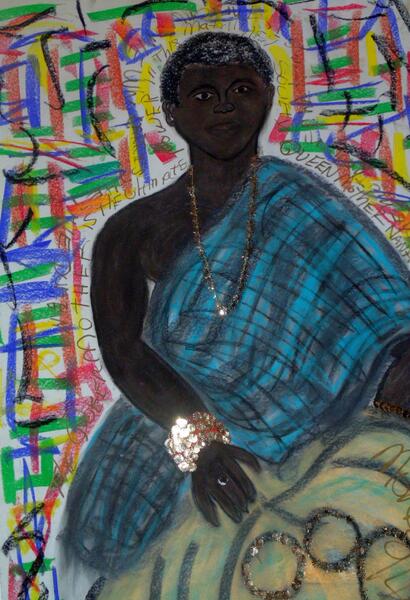 Queen Mother Nana of The Ashanti48in x 36in. Mixed media on paper with found objects.
Queen Mother Nana of The Ashanti48in x 36in. Mixed media on paper with found objects. -
 Queen Victoria of Great Britain48in x 36in. Mixed media on paper with found objects.
Queen Victoria of Great Britain48in x 36in. Mixed media on paper with found objects. -
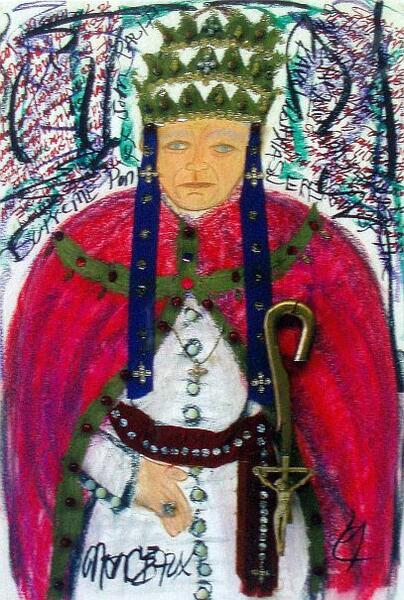 Supreme Pontiff John Paul II48in x 36in. Mixed media on paper with found objects.
Supreme Pontiff John Paul II48in x 36in. Mixed media on paper with found objects. -
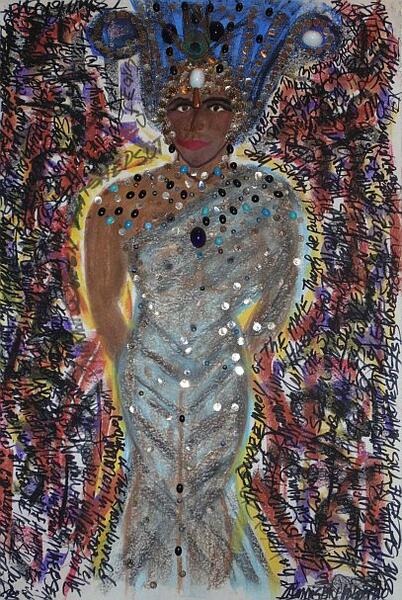 Queen Hatshepsut of Egypt48in x 36in. Mixed media on paper with found objects.
Queen Hatshepsut of Egypt48in x 36in. Mixed media on paper with found objects.
Shall We Dance
It was because of a personal chat with Janet Collins in Seattle, Washington, that the series got started. I made notes from that conversation which became the basis for the series.
-
Shall We DanceThis show tune, taken from the 1951 Rogers and Hammerstein musical, "The King and I", is the song I chose to accompany this series.
-
 Alvin Ailey60in x 40in. Mixed media on paper with found objects.
Alvin Ailey60in x 40in. Mixed media on paper with found objects. -
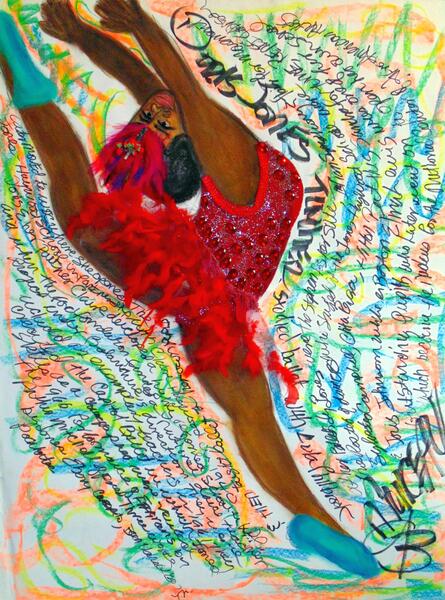 Doris Jones Turner60in x 40in. Mixed media on paper with found objects.
Doris Jones Turner60in x 40in. Mixed media on paper with found objects. -
 Eleo Pomare60in x 40in. Mixed media on paper with found objects.
Eleo Pomare60in x 40in. Mixed media on paper with found objects. -
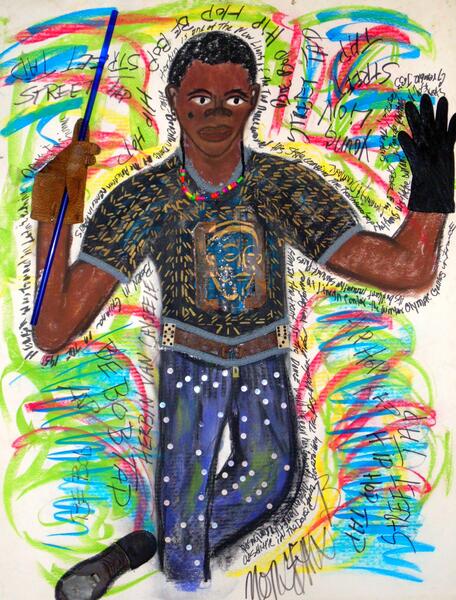 Herbin van Caysee60in x 40in. Mixed media on paper with found objects.
Herbin van Caysee60in x 40in. Mixed media on paper with found objects. -
 Janet Collins60in x 40in. Mixed media on paper with found objects.
Janet Collins60in x 40in. Mixed media on paper with found objects. -
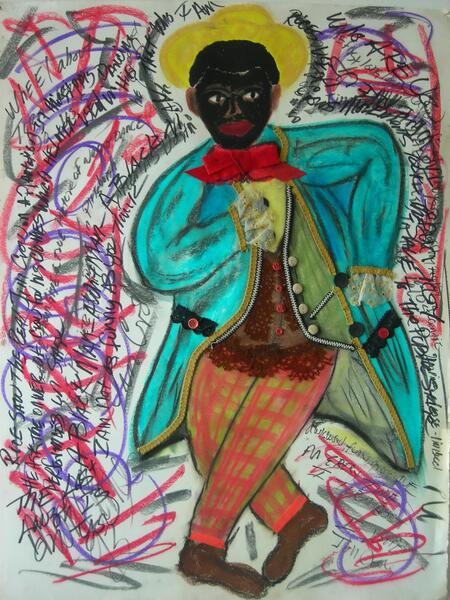 Jim Crow60in x 40in. Mixed media on paper with found objects.
Jim Crow60in x 40in. Mixed media on paper with found objects. -
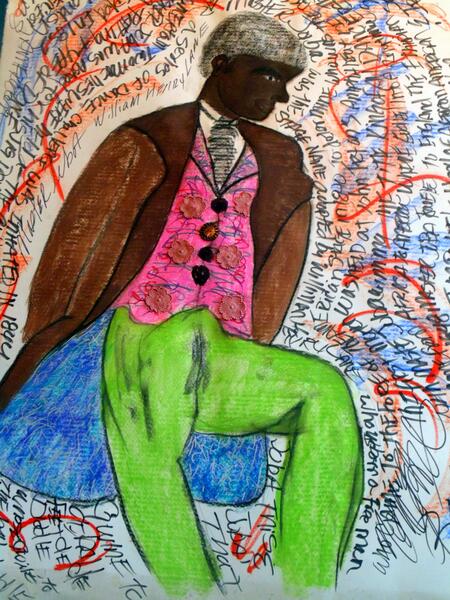 Master Jubbaa.k.a. William Henry Lane. 60in x 40in. Mixed media on paper with found objects.
Master Jubbaa.k.a. William Henry Lane. 60in x 40in. Mixed media on paper with found objects. -
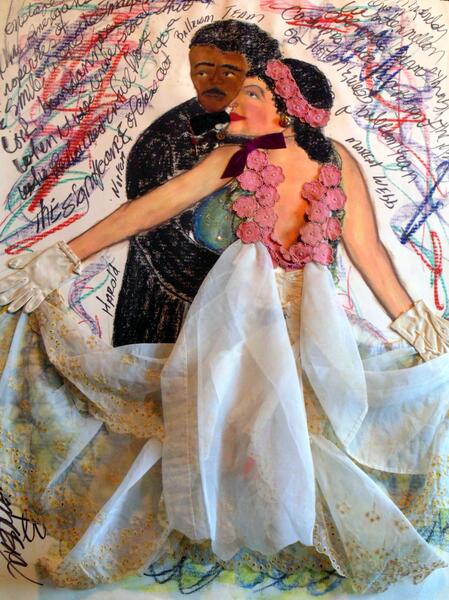 Harold Norton and Margot WebbBallroom dancers. 60in x 40in. Mixed media on paper with found objects.
Harold Norton and Margot WebbBallroom dancers. 60in x 40in. Mixed media on paper with found objects. -
 Talley Beatty60in x 40in. Mixed media on paper with found objects.
Talley Beatty60in x 40in. Mixed media on paper with found objects.
Shadowball
Throughout the 19th and 20th centuries, sports fans were wildly enthusiastic about America's national pastime' - baseball. Yet, beyond a handful of superstars, the colorful legacy of the Negro Leagues remains essentially unknown.
In the tradition of the artist as griot, Morgan Monceaux brings to life a crucial scenario. He chronicles a broader history of baseball while reflecting on the ongoing struggle for justice and equal rights in America.
“Shadowball” pays artistic homage to the unsung black legends of baseball. Comprising a series of 42 x 30-inch mixed media works on paper, Monceaux utilizes a variety of traditional art media and diverse materials to portray these men and women.
Excerpt taken from monograph written for the series by Claude Elliott, Independent Curator
-
The Negro LeaguesTrack number one from the "Shadowball" audio CD specially prepared for the series by educator and performance artist Rochel Garner Coleman.
-
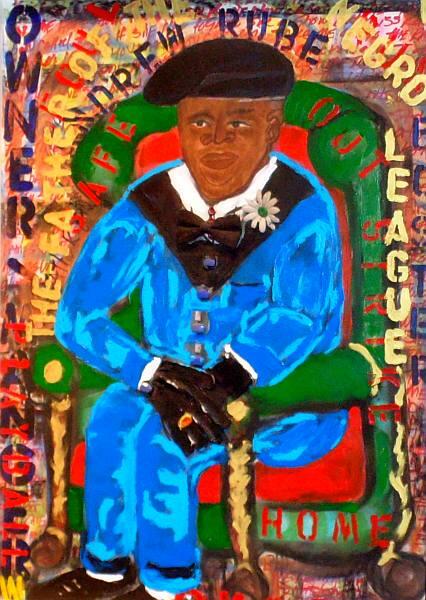 Andrew FosterOften referred to as the Father of the Negro Leagues. 42in x 30in. Mixed media on paper with found objects.
Andrew FosterOften referred to as the Father of the Negro Leagues. 42in x 30in. Mixed media on paper with found objects. -
 Effa Manley42in x 30in. Mixed media on paper with found objects.
Effa Manley42in x 30in. Mixed media on paper with found objects. -
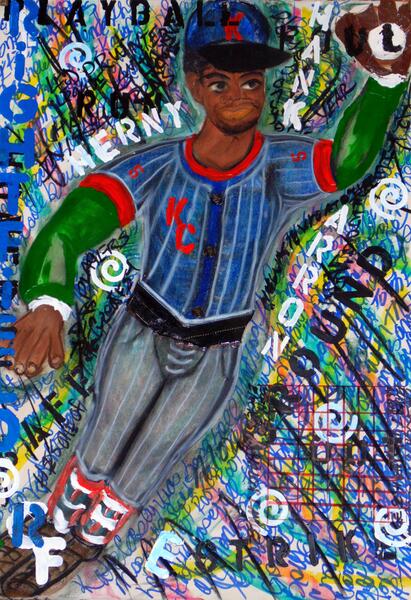 Henry AaronHenry 'Hank' Aaron. 42in x 30in. Mixed media on paper with found objects.
Henry AaronHenry 'Hank' Aaron. 42in x 30in. Mixed media on paper with found objects. -
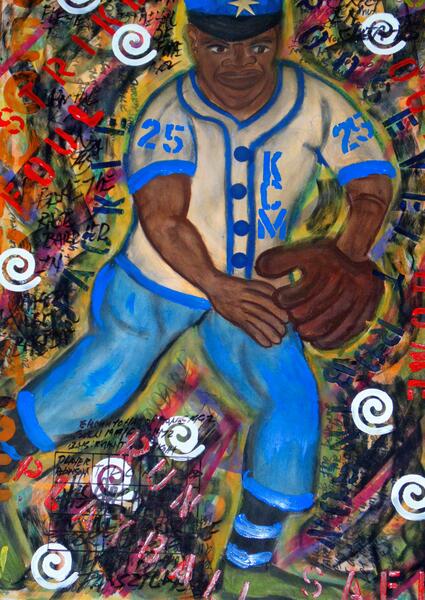 Jackie Robinson42in x 30in. Mixed media on paper with found objects.
Jackie Robinson42in x 30in. Mixed media on paper with found objects. -
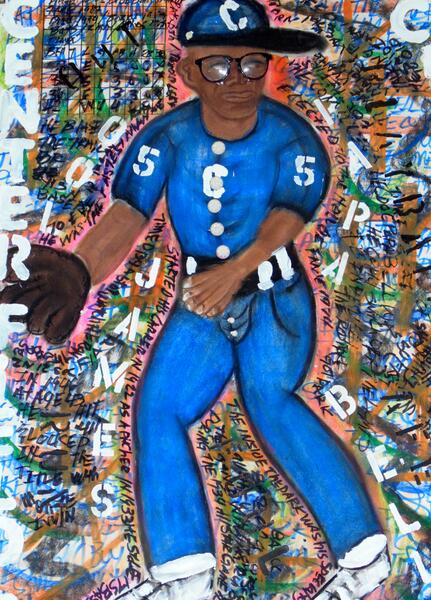 James ThomasJames 'Cool Papa Bell' Thomas. 42in x 30in. Mixed media on paper with found objects.
James ThomasJames 'Cool Papa Bell' Thomas. 42in x 30in. Mixed media on paper with found objects. -
 Leroy PaigeLeroy 'Satchel' Paige. 42in x 30in. Mixed media on paper with found objects.
Leroy PaigeLeroy 'Satchel' Paige. 42in x 30in. Mixed media on paper with found objects. -
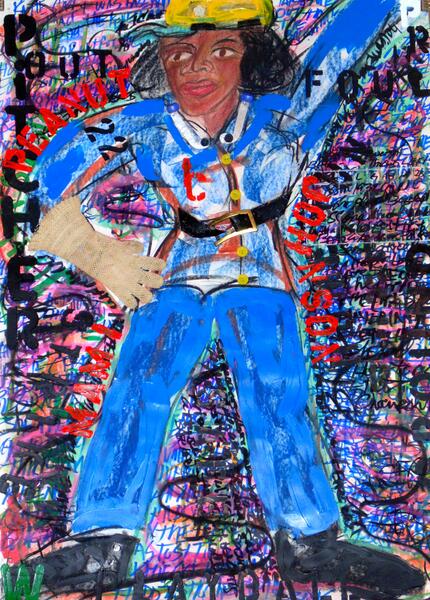 Mamie JohnsonMamie 'Peanut' Johnson. So called because of her size. 42in x 30in. Mixed media on paper with found objects.
Mamie JohnsonMamie 'Peanut' Johnson. So called because of her size. 42in x 30in. Mixed media on paper with found objects. -
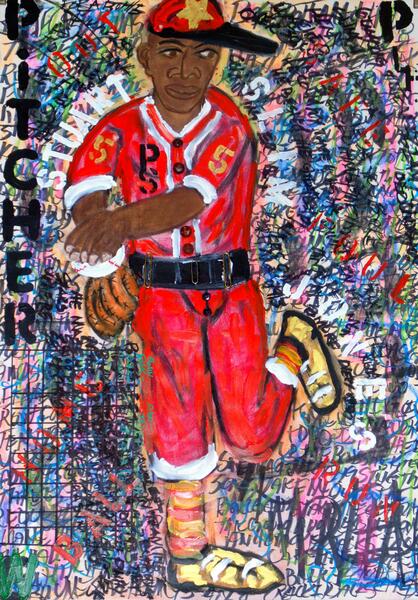 Stuart JonesStuart 'Slim' Jones. 42in x 30in. Mixed media on paper with found objects.
Stuart JonesStuart 'Slim' Jones. 42in x 30in. Mixed media on paper with found objects. -
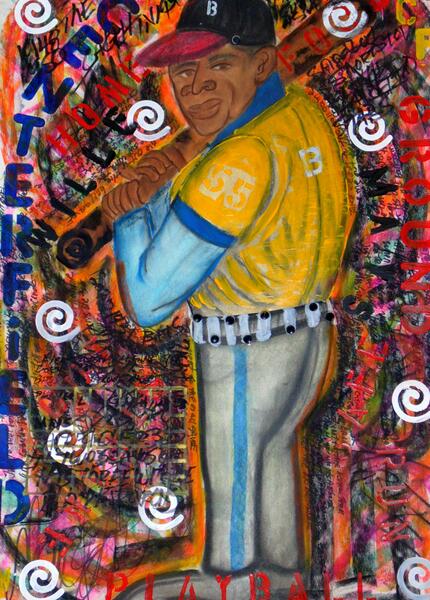 Willie Mays42in x 30in. Mixed media on paper with found objects.
Willie Mays42in x 30in. Mixed media on paper with found objects.
Exegesis (The Black Bible Series)
This series, which follows in the tradition of religious art by artists in general, and African American artists in particular, aims to shift the conversation from merely viewing my work to actively critiquing/discussing/debating it within academia, churches, galleries, public places and online spaces. I am particularly keen to not only gauge responses to this series, but also to observe – where possible - such responses and to engage viewers and participants in a dialogue with a view to producing – it is hoped – positive outcomes. The work is comprised of paintings, black and white linocut prints, and sermons; the latter being contributed by ministers, non-ministers, and students of Biblical Hebrew and Greek, regardless of denomination/religion, race, theological training (or lack of it), gender or sexual orientation.
My approach is different in the sense that, while one might wish to make links of my work with the Civil Rights, Black Power and Afrocentrist movements, it is not about documenting myth and teaching it as historical fact in order to boost the self-esteem of African Americans, as is/was the case with Afrocentrism. It is about offering an alternative view that challenges pre-conceived notions long held dear by Black (esp.) Christians while remaining within accepted theological and historical parameters. On the other hand, if positive self-esteem or a change in perceptions/attitudes arises as a result of viewing and engaging with the work, and that engagement is underpinned by appropriate reflection, then I would consider either to be an acceptable outcome.
In the shift from portraiture to a “visual exegesis”, some have asked me why it took so long to do “Exegesis”. In 2012 when I was undergoing a femoral bypass I died – on the sixth of seven operations - and experienced the void. Or perhaps, more accurately, what I perceived to be nothingness. I came to the conclusion that everything that I had learned about Christianity had been a lie. Not to mention the sexual hypocrisy, superficiality and lack of charity I had observed and experienced particularly in my earlier years. When I returned from this experience, I resolved that I would begin preaching my sermons. However, it took me a very long time to digest what had happened to me. Nonetheless, I found my way to doing the series through attempting a new art form, that of quilting. Quilting became the catalyst I needed because it evoked memories of my childhood when I would watch my great-grandmother making quilts.
-
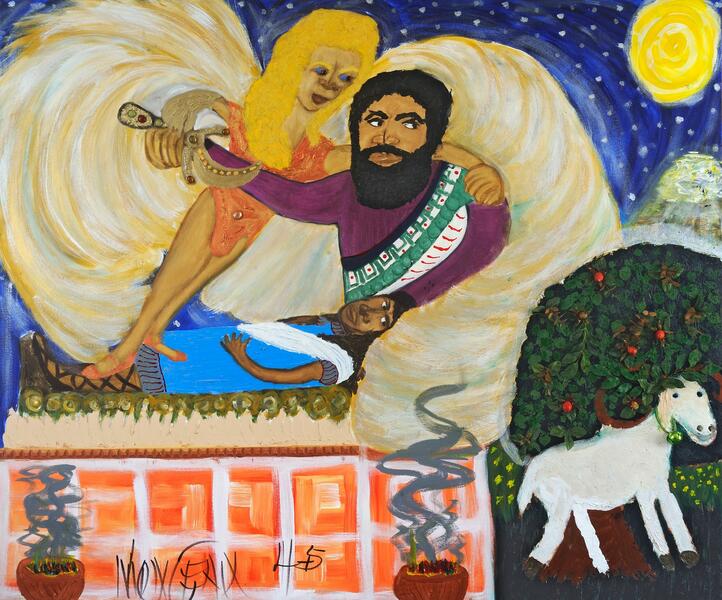 Abraham's Secret60in x 70in. Oils and acrylics with mixed media and found objects on canvas.
Abraham's Secret60in x 70in. Oils and acrylics with mixed media and found objects on canvas. -
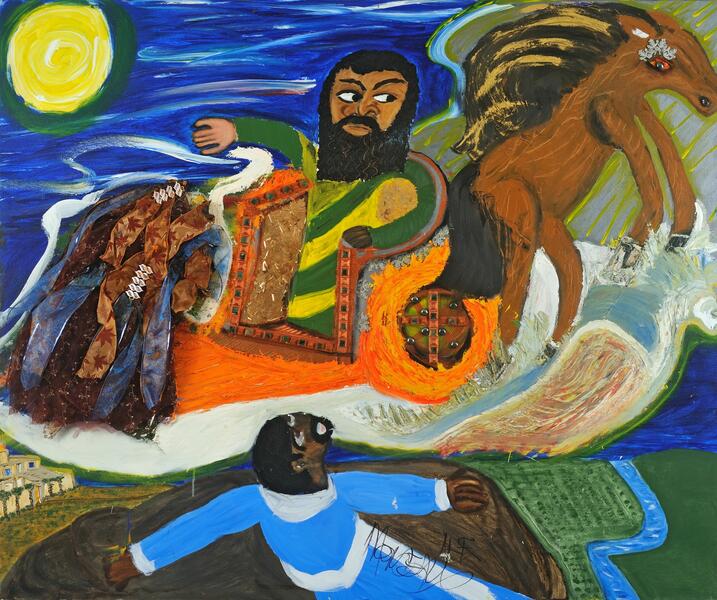 Elijah's Chariot of Fire60in x 70in. Oils and acrylics with mixed media and found objects on canvas.
Elijah's Chariot of Fire60in x 70in. Oils and acrylics with mixed media and found objects on canvas. -
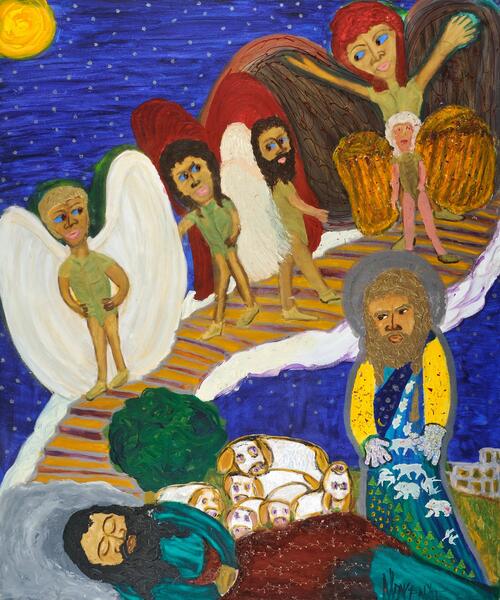 Jacob's Wonderful Dream70in x 60in. Oils and acrylics with mixed media and found objects on canvas.
Jacob's Wonderful Dream70in x 60in. Oils and acrylics with mixed media and found objects on canvas. -
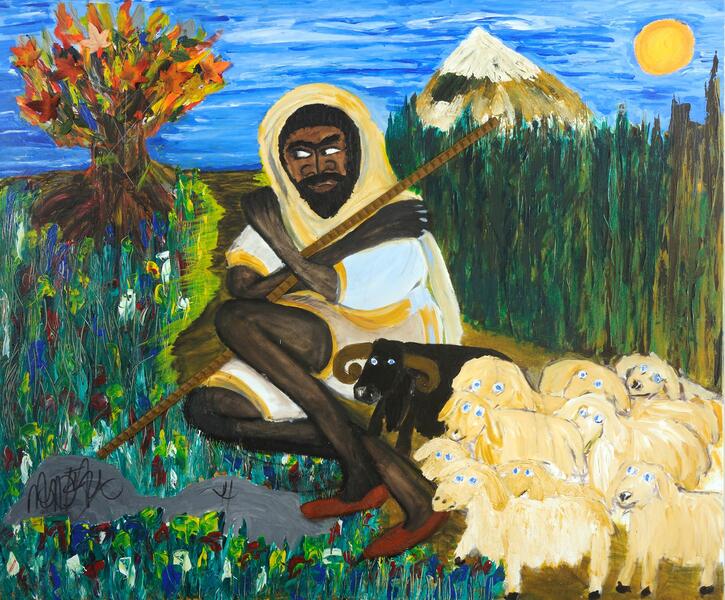 Moses and The Burning Bush60in x 70in. Oils and acrylics with mixed media and found objects on canvas.
Moses and The Burning Bush60in x 70in. Oils and acrylics with mixed media and found objects on canvas. -
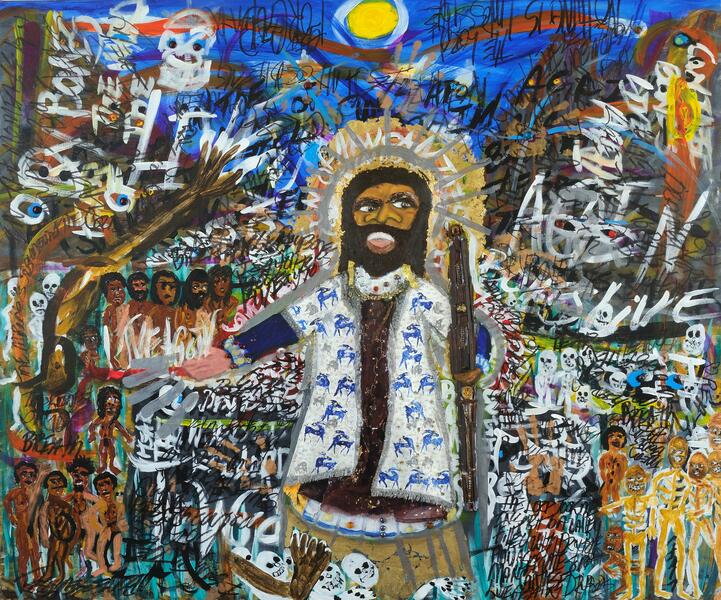 The Valley of Dry Bones60in x 70in. Oils and acrylics with mixed media and found objects on canvas.
The Valley of Dry Bones60in x 70in. Oils and acrylics with mixed media and found objects on canvas. -
 The Flight Into Egypt60in x 70in. Oils and acrylics with mixed media and found objects on canvas.
The Flight Into Egypt60in x 70in. Oils and acrylics with mixed media and found objects on canvas. -
 The Offer of The Morning Star"The Offer of the Morning Star: Turn These Stones into Bread." Of this painting, Morgan says, "When women look at Lucifer, they see a man. When men look at Lucifer, they see a woman." 70in x 60in. Oils and acrylics with mixed media and found objects on canvas.
The Offer of The Morning Star"The Offer of the Morning Star: Turn These Stones into Bread." Of this painting, Morgan says, "When women look at Lucifer, they see a man. When men look at Lucifer, they see a woman." 70in x 60in. Oils and acrylics with mixed media and found objects on canvas. -
 The Reveal73.5in x 72in. Oils and acrylics with mixed media and found objects on canvas.
The Reveal73.5in x 72in. Oils and acrylics with mixed media and found objects on canvas. -
 We Are Legion60in x 70in. Oils and acrylics with mixed media and found objects on canvas.
We Are Legion60in x 70in. Oils and acrylics with mixed media and found objects on canvas. -
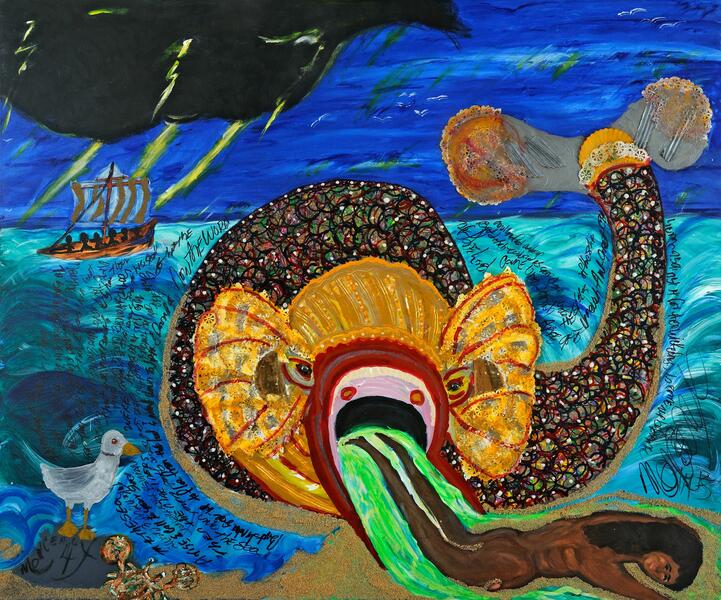 Jonah and The Leviathan60in x 70in. Oils and acrylics with mixed media and found objects on canvas.
Jonah and The Leviathan60in x 70in. Oils and acrylics with mixed media and found objects on canvas.
Linocuts
-
 The Golden Child19in x 24in. Black and white linocut print. Includes the use of oil-based inks. From the Exegesis (Black Bible) series.
The Golden Child19in x 24in. Black and white linocut print. Includes the use of oil-based inks. From the Exegesis (Black Bible) series. -
 The Diamond Bevy19in x 24in. Black and white linocut print. Includes the use of oil-based inks. From the Shadowball series.
The Diamond Bevy19in x 24in. Black and white linocut print. Includes the use of oil-based inks. From the Shadowball series. -
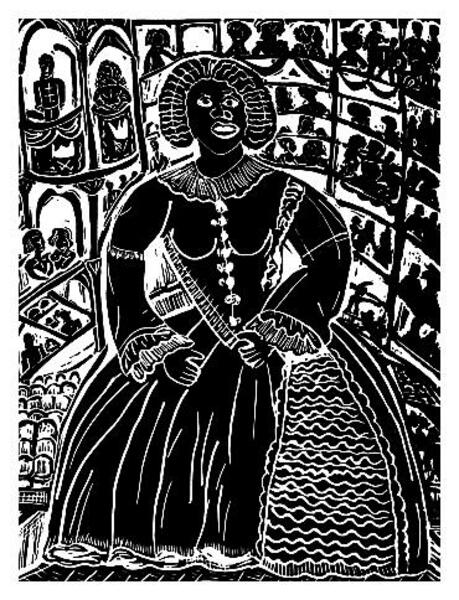 Elizabeth Taylor-GreenfieldThe Black Swan sings "I Know That My Redeemer Liveth". From the Divas series. 14in x 18in. Includes the use of oil-based inks.
Elizabeth Taylor-GreenfieldThe Black Swan sings "I Know That My Redeemer Liveth". From the Divas series. 14in x 18in. Includes the use of oil-based inks. -
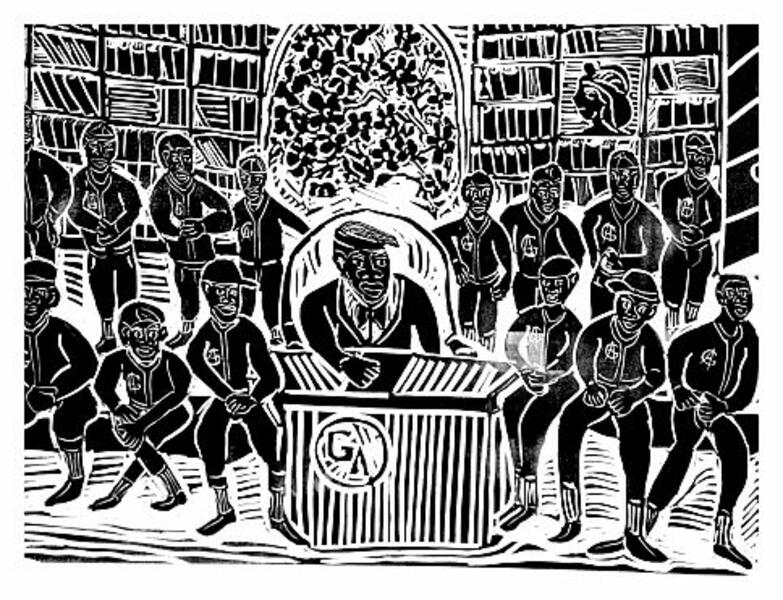 Father of The Negro LeaguesBlack and white linocut print. Includes the use of oil-based inks. From the Shadowball series.
Father of The Negro LeaguesBlack and white linocut print. Includes the use of oil-based inks. From the Shadowball series. -
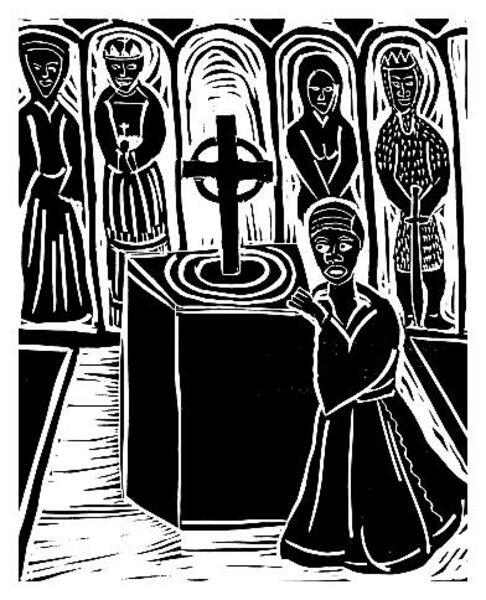 Hilda HarrisHilda Harris in the Martyrdom of St. Magnus. Black and white linocut print. From the Divas series. 14in x 18in. Includes the use of oil-based inks.
Hilda HarrisHilda Harris in the Martyrdom of St. Magnus. Black and white linocut print. From the Divas series. 14in x 18in. Includes the use of oil-based inks. -
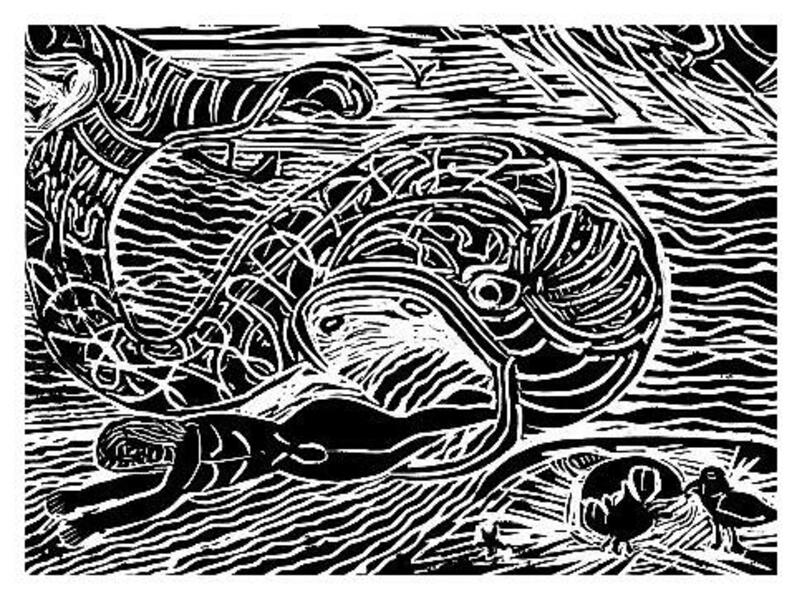 Jonah and The LeviathanBlack and white linocut print. 26.5 x 43in. Includes the use of oil-based inks. From the Exegesis (Black Bible) series.
Jonah and The LeviathanBlack and white linocut print. 26.5 x 43in. Includes the use of oil-based inks. From the Exegesis (Black Bible) series. -
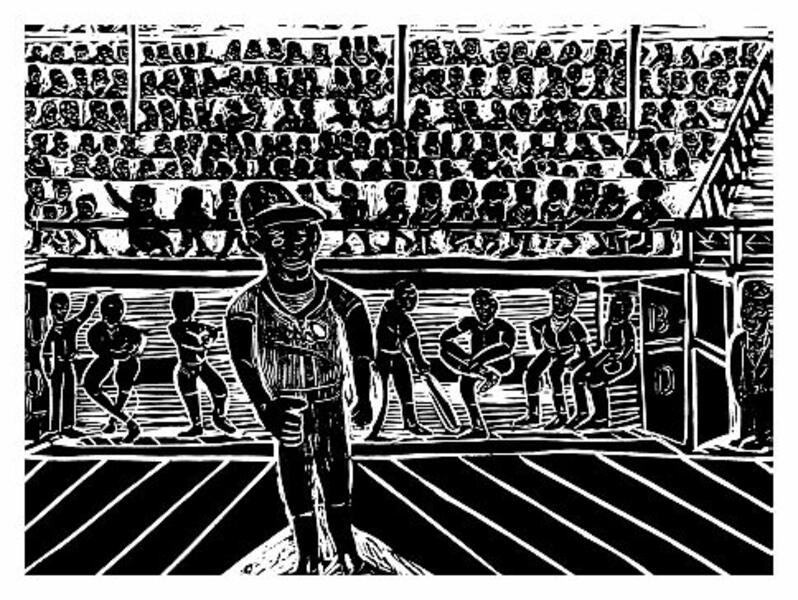 Get That Nigger Off The Field 1Black and white linocut print. Includes the use of oil-based inks. From the Shadowball series.
Get That Nigger Off The Field 1Black and white linocut print. Includes the use of oil-based inks. From the Shadowball series. -
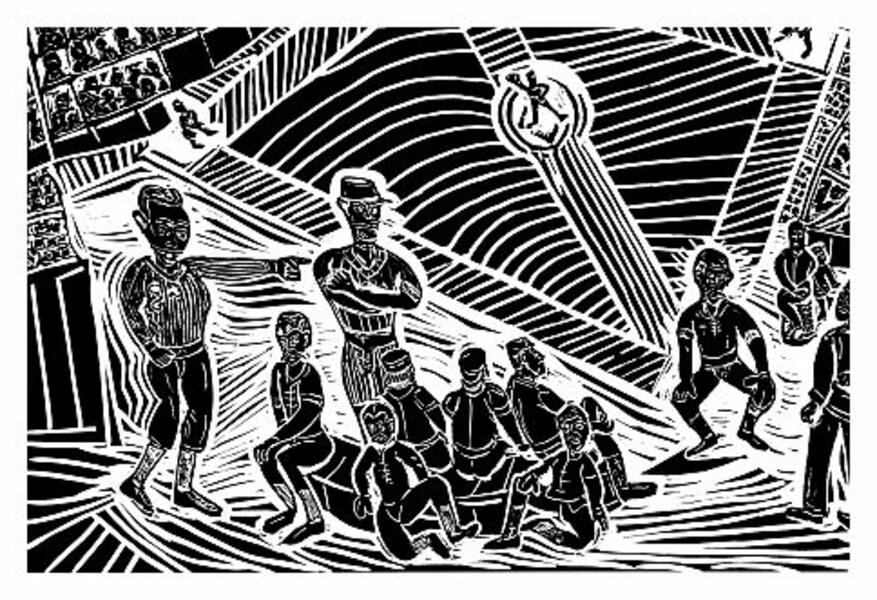 Get That Nigger Off The Field 2Black and white linocut print. Includes the use of oil-based inks. From the Shadowball series.
Get That Nigger Off The Field 2Black and white linocut print. Includes the use of oil-based inks. From the Shadowball series. -
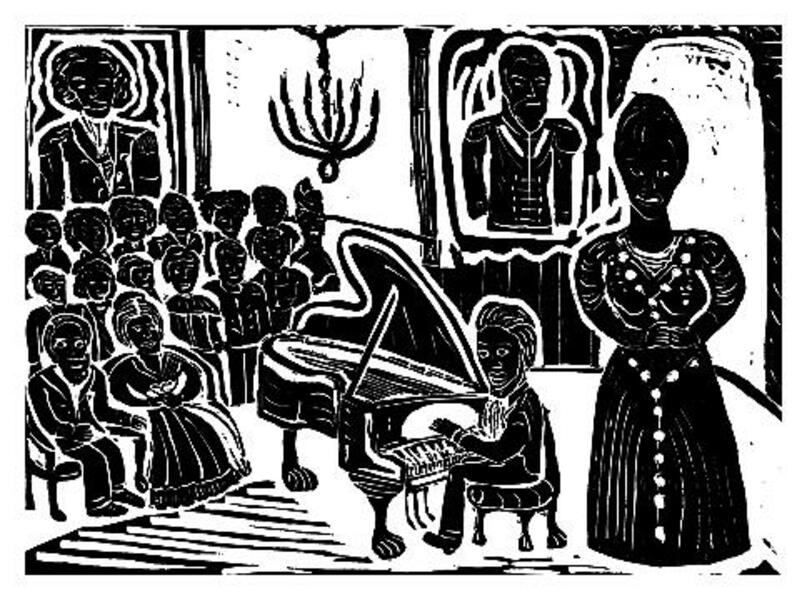 Sissieretta JonesSissieretta Jones sings "The Last Rose of Summer". 14in x 18in. Black and white linocut print. Includes the use of oil-based inks. From the Divas (And So I Sing) series.
Sissieretta JonesSissieretta Jones sings "The Last Rose of Summer". 14in x 18in. Black and white linocut print. Includes the use of oil-based inks. From the Divas (And So I Sing) series. -
 Slim JonesBlack and white linocut print. 22.5in x 30in. Includes the use of oil-based inks. From the Shadowball series.
Slim JonesBlack and white linocut print. 22.5in x 30in. Includes the use of oil-based inks. From the Shadowball series.
